2025-11-26 01:15:10
Ever present in my mind is The List: the countries I still haven’t gone to that I most want to visit.
Ethiopia is on The List. So is Indonesia. And South Korea. And Madagascar. And Taiwan.
Early on, my wife and I pledged to visit two new countries every year, and we mostly pulled it off. Then came Covid, followed by two babies, and we fell off the wagon.
This year we remembered that we were gonna die at some point and decided it was time to get things going again. We dusted off The List, picked a country that’s been at the very top for years, tossed the kids to the grandparents for a week, and headed off to Bhutan.1
Bhutan, if you’re not familiar, is a tiny 800,000-person country squashed between two behemoths.

Bhutan was unified in the 17th century after millennia of existing as a collection of warring tribes. In the time since then, it has somehow avoided being annexed by China or India. Today, it is the world’s last Buddhist kingdom, and I can confirm that it is both very Buddhist and very kingdom-y. Temples are everywhere, and the people are highly superstitious—our tour guide seemed to constantly be remarking about good luck and bad luck, promising omens and inauspicious riverbends. (The temples are beautiful, but so are all the other buildings. All architecture in the country, from the airport to the shopping centers, has a uniform Bhutanese style.)

The king is universally beloved and, at least the way they tell it, an exemplary ruler. A typical story we heard: 50,000 people work in the country’s tourist industry, all of whom were suddenly out of work during Covid. So the king gave these families $120/month, enough to get by on until the industry came back. He paid this out of his own pocket, nearly to the point of personal bankruptcy.

(Of course, I was also told in North Korea that it was only by the grace and courage of their magnanimous leaders that the people were prosperous and free, unlike their unfortunate South Korean cousins suffering under American occupation. But the situations are wildly different and I am inclined to mostly believe what I heard in Bhutan.)
One more story to illustrate what a sweetie Bhutan is: The country has a strict policy against killing animals and never euthanizes stray dogs, so there are a lot of them. They mostly live off the detritus of restaurants and hotels. When everything shut down during Covid, the king told people to bring cooked food out to the dogs and even wrap them in blankets during the cold months.
Bhutan does things differently than other countries. Hellbent on preserving their traditional way of life, TV and internet were banned in the country until 1999, and if it weren’t for the cars, I might have been convinced I had taken a time machine back to the 1600s. Tourism is limited, only possible in the form of a guided tour, and immigrating to the country is near impossible. They are so diligent about conservation that Bhutan is the world’s one carbon-negative country—their vast forests absorb more CO2 than their populace emits.
In 1972, Bhutan’s king decided that Gross National Happiness was a more important metric than Gross Domestic Product, and their policies cater to this value.2 It’s why Bhutan is famous for supposedly being the world’s happiest country, which I had no way to verify, but the people were very kind and seemed pretty happy I guess?
Sadly, Bhutan’s way of life is threatened now as many of its young people have left to find opportunity elsewhere. The king is attempting to fix this with plans to construct Gelephu Mindfulness City, an economic hub which will center around innovation, while preserving Bhutanese tradition. It looks like it’ll be incredible, though I was told not to hold my breath as it will probably not be finished for 20 more years.
All of this is to say that Bhutan is a special place—remote, mysterious, and breathtakingly beautiful. Which is why it was always prominently on The List.
A trip to Bhutan is better shown than told, so I kept most of the details to this video:

_______
More posts from The List:
Siberia
Tokyo
Nigeria
Iraq
Greenland
North Korea
And The genie question
_______
If you like Wait But Why, sign up for our email list and we’ll send you new posts when they come out.
To support Wait But Why, visit our Patreon page. (During this book-writing phase, I’ve been doing mini-posts every Friday for patrons.)
It is not quick to get from Austin to Bhutan. We had to get there by way of Chicago, Zurich, and Delhi.↩
In 2011, the UN passed a resolution being like, “all of you other shitty countries should consider focusing on Gross National Happiness too.” Everyone appears to have ignored them.↩
The post The sights and sounds of Bhutan appeared first on Wait But Why.
2025-10-24 20:36:56
Back in 2023, I wrote a post about having my first baby and all the things that confused me about doing so.
Earlier this year, it happened again. Just like that, I was back here:

On one hand, now time doesn’t exist at all.

On the other hand, the second child is…easier than the first.
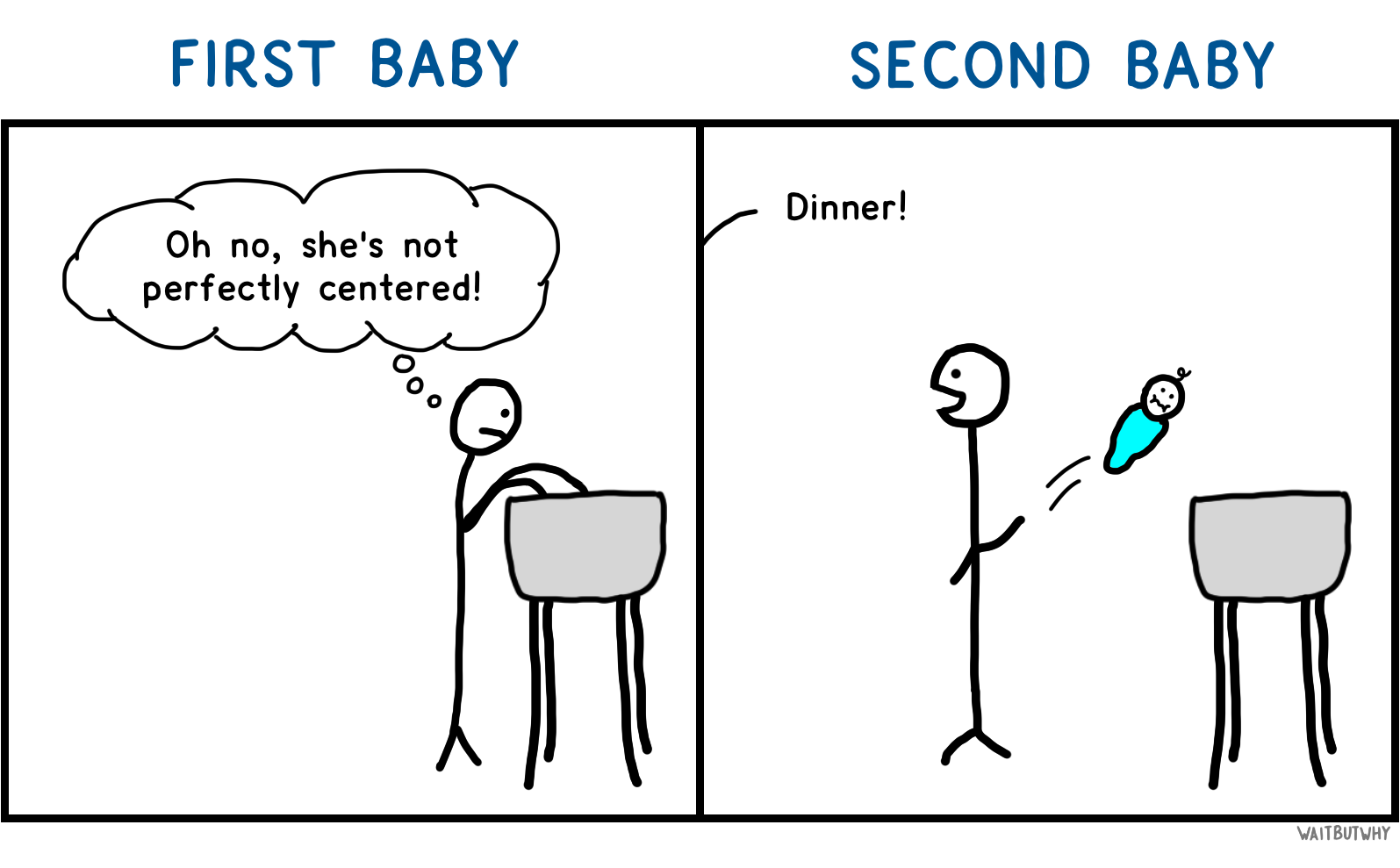
But I’m not here to talk about the new baby, delightful and obese as she may be. Today, I report to you from the depths of toddler parenthood. I always thought two-year-olds were basically unconscious blobs with a cold, but it turns out they’re actual people you can get to know. Having now spent some time cohabitating with one, I’ve made the following discoveries:
Sometimes when I’m working in my office, my daughter will toddle in, run over to me, and give me a hug. It is by far the best part of my day. Her smile fills me with utter joy. Her little voice is sent straight from heaven. I feel the purest possible love for her.
It’s just that I also find her groundbreakingly boring. A five-minute hangout is one thing, but when I’m deep in an afternoon with her, it’s hard to come to any other conclusion than that I’ve spent my last three hours with a person whose IQ is 20.

It’s well-known that toddlers transform into mid-20th-century totalitarian dictators at the drop of a hat.
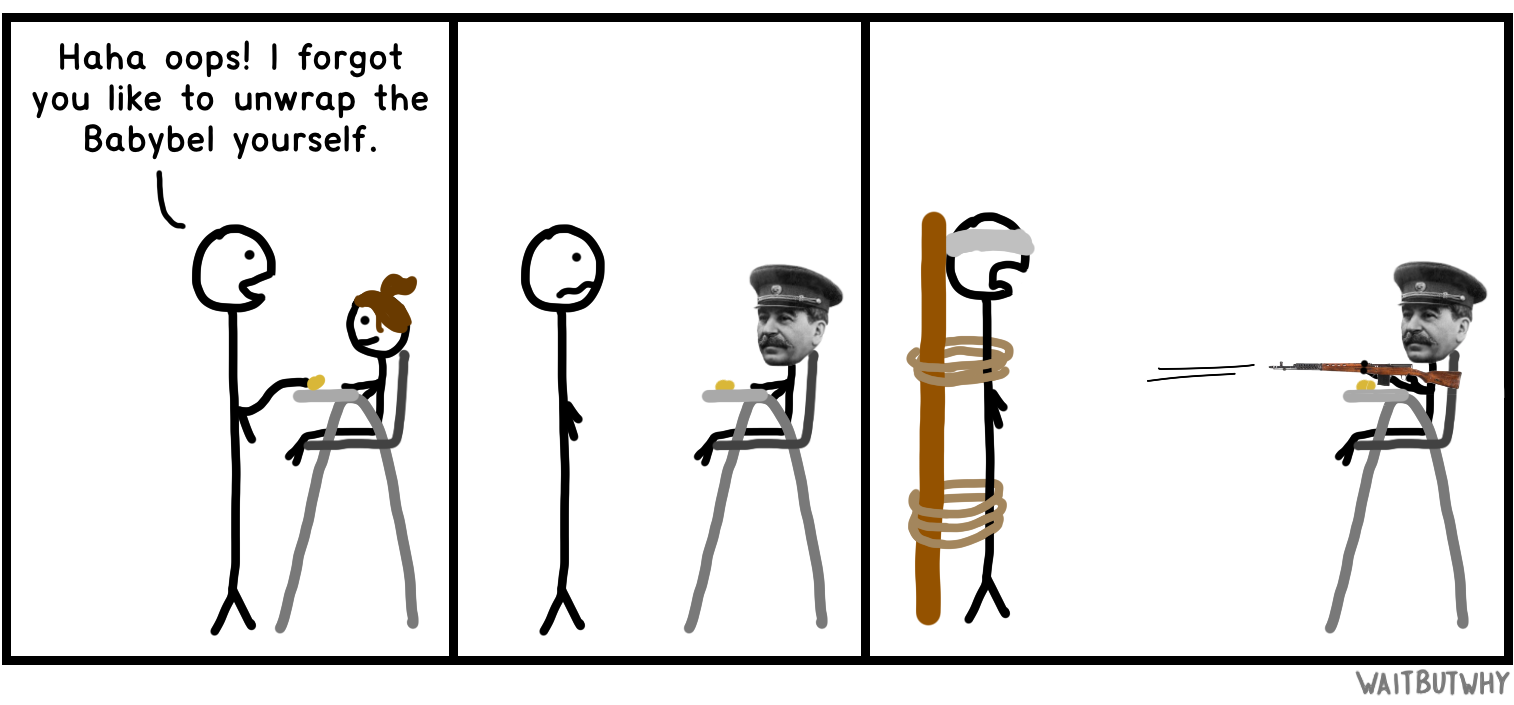
But they’re dicks in less obvious ways too. The other day, my toddler was playing with Legos. I sat down next to her and asked her what she was building, and she said, “Daddy needs to work in his office?”—an unsubtle hint that I should leave her the fuck alone.
Or the times I cook a whole thing for her with care and love and she refuses to take a bite, making me feel cluey for myself.
Most recently, I made the mistake of telling her my age, and now she says “Daddy is 43” like 30 times a day, constantly filling me with existential dread.
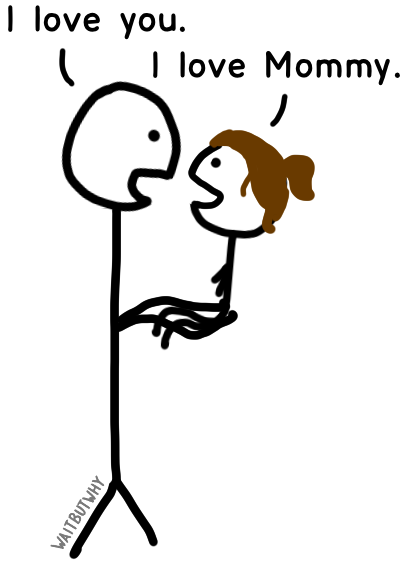
Toddler parenthood is a reality distortion zone that makes it hard to remember that most people find your toddler breathtakingly uninteresting.1
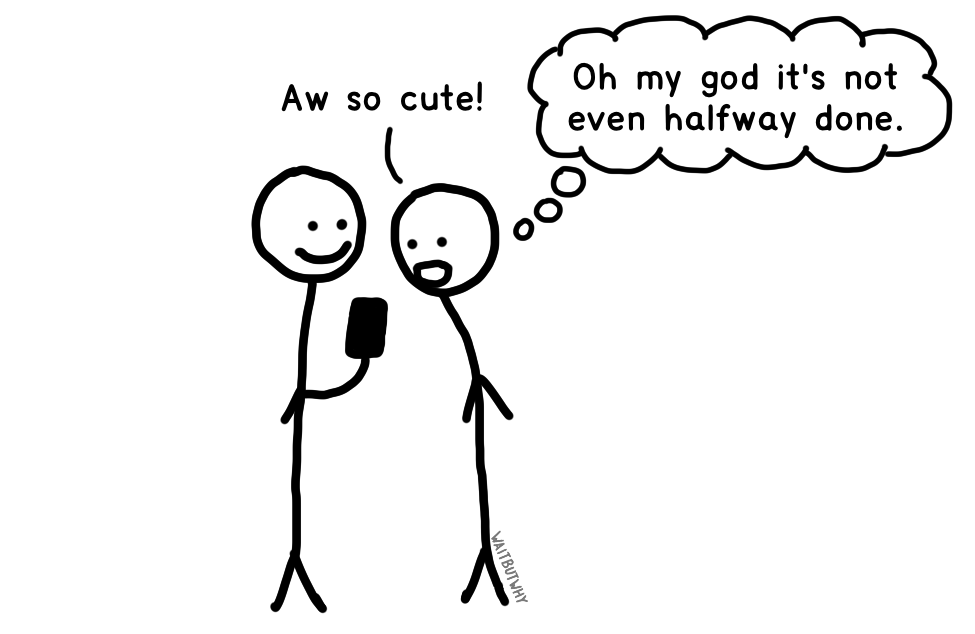
Friends who have kids the same age as yours are kind of in a cohort together, so parents of toddlers often end up with a whole throng of toddlers in their lives. Amongst my cohort I’ve both been an offender and frequent victim of toddler-video-showing. It’s part of the tax we all pay.2
I try to at least minimize the fallout from my end.

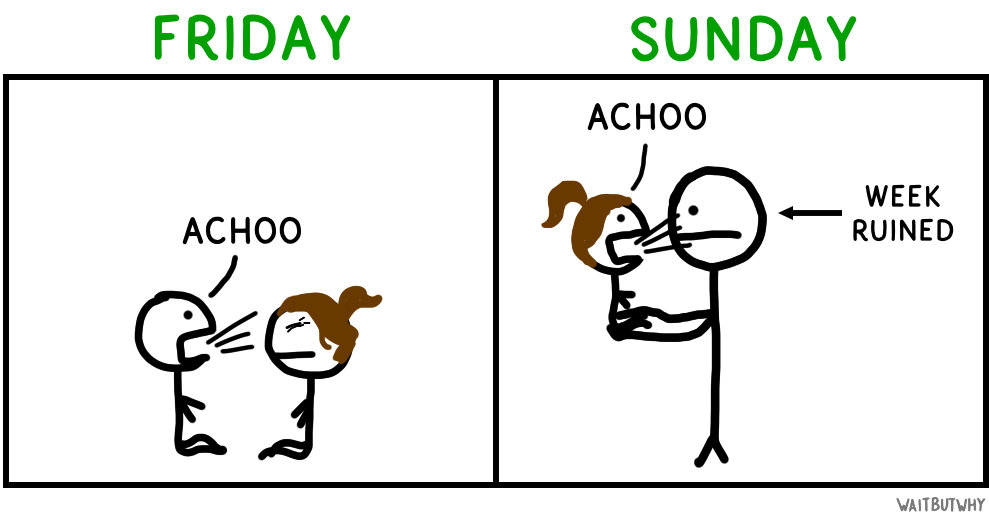
If I took my daughter to China for a year, and we just lived there with no language instruction, I’d come back knowing approximately six Mandarin words and she’d be fluent. It makes no sense to me that toddlers just learn a language by hearing the language, but somehow they do. They’re weird freak geniuses. But then she says stuff like “would you like a strawberry?” when she wants a strawberry, because when we say “you,” it refers to her, so she now thinks “you” is a synonym for her name, which is very unimpressive.
Likewise, the other day I read her a new book for the first time, and then the second time I read it to her, she stopped me in the middle to correct something I said. It turns out I had accidentally skipped a word, which she knew because she somehow memorized the whole book on the first read. But then we’ll pick up another book and she’ll stare at the page for a million years looking for where Curious George is “hiding” even though he’s obviously right the fuck there.
We sometimes take our toddler to story time at the library, where the librarian reads a book to a bunch of kids. The first time we took her, she decided to take matters into her own hands and, mid-story, went and sat in the librarian’s lap. The issue is that she hadn’t quite figured out that the world does not exist entirely for her benefit.
It’s understandable. You’re born into the world and for the first few years, everyone you see smiles and waves at you, so you overestimate your importance. Only slowly do you learn what’s really happening.3
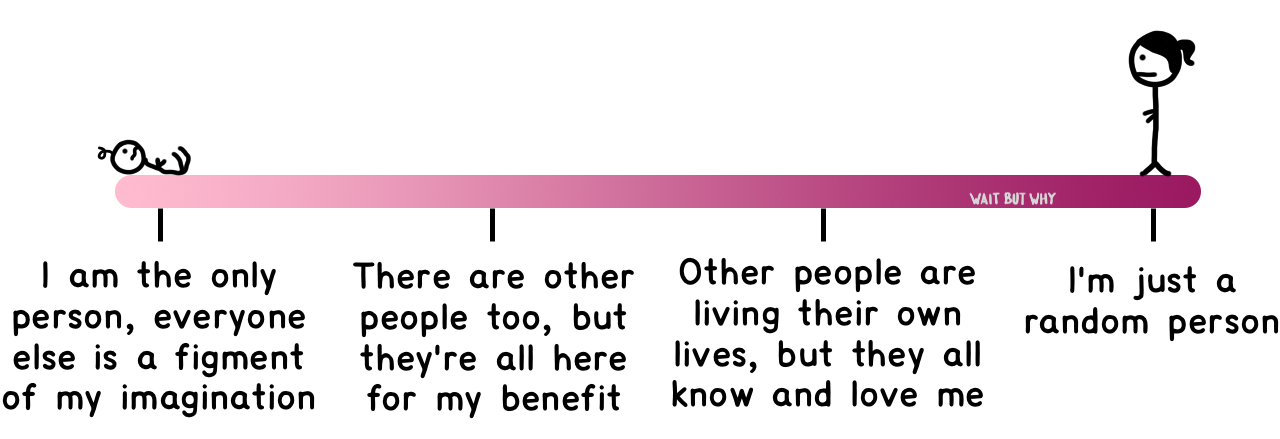
This is part of the broader phenomenon of a toddler not really having any idea what’s going on. They don’t know about death, or money, or history, or sex, or the Big Bang, or basically anything about reality. They just emerged out of nowhere and started being, which for some reason doesn’t strike them as weird or confusing.
(A good “do you have any idea what’s going on?” litmus test is: If you’re walking down the street and an elephant flies down from the sky, hovers ten feet above you and says hello in a silly cartoon voice before flying off, would you be like “OH MY GOD WHAT JUST HAPPENED” or would you shrug and be like “I guess that’s something that happens”? If the latter, you have no idea what’s going on. Most two-year-olds fail this test.)
My daughter is remarkably unfunny. Once when she dropped something, I said “kerplunk,” and she found it fucking hilarious. For the next ten minutes, she kept picking things up, dropping them, and saying “kerplunk,” hysterically laughing each time.
But unintentionally, she’s a comedic genius. When I was in her way recently, she said, “Can you get out of space?” which my wife and I now say to each other whenever we want the other to move. Another time, we had to rip a band-aid off her leg, after which she said, “I am so perfectly sad,” and now my wife and I say that anytime we’re unhappy about something.4
We’ve also discovered an amazing hack: you can just teach a toddler to say whatever you want. We taught her to say “mamma mia” whenever she falls over, which I highly recommend to other toddler parents.

The problem is, for every strong opinion, there’s an equally strong opposite opinion.

I’ve taken to accepting that I’m messing up all kinds of things, and mainly just try to have fun with my little friend. To the extent that I have a strategy, it’s basically:
Toddler parents can take solace in the fact that parenting probably matters less than we think it does. Rather than try to shape our little two-foot-tall companions, we should help guide them to become the best version of who they already are.
Anyway, gotta go. Time to read Squeak the Mouse Likes His House for the 57th time.
___________
More tales from fatherhood: 10 Thoughts from the Fourth Trimester
My favorite toddler books: Flotsam, Little Fur Family, The Giant Jam Sandwich, Little Owl’s Night
If you’d rather read about something other than my fat babies:
The Marriage Decision: Everything Forever or Nothing Ever Again
Taming the Mammoth: Why You Should Stop Caring What Other People Think
_______
If you like Wait But Why, sign up for our email list and we’ll send you new posts when they come out.
To support Wait But Why, visit our Patreon page.
Toddler grandparents may be an exception, though they span a wide range, from “Please go away for a month and leave them with me” on one end, to “I will play with them for five minutes but only because it looks bad if I don’t” on the other. Those on the latter end are as bored by toddler videos as everyone else.↩
There’s a range here. A short, high-quality video of a good friend’s toddler, sent by text (so you can watch on your own time and don’t have to react the whole time) is fine—nice even. A person you barely know showing you a long toddler video, in person, is a nightmare.↩
Some have suggested that the common desire for fame is, in some subconscious sense, an attempt to recapture the long-lost feeling that the whole world knows and loves you.↩
She actually said “Can I get out of space?” and “You are so perfectly sad” because, again, she is confused about pronouns.↩
The post Tales from Toddlerhood appeared first on Wait But Why.
2024-02-10 02:24:38
I’m writing this on a 30-foot screen on top of a 10,000-foot mountain in Hawaii, at a table in an Austin coffee shop where I’m pretty sure other people are taking photos of me to send to their friends so they can all call me a piece of shit. In the last week, life has gotten weird.
My journey to the Haleakalā shield volcano Austin coffee shop began more than 30 years ago, in 1990, when my parents brought me to something called a “virtual reality exhibit” at the Seaport World Trade Center in Boston. I stood on a little circular pedestal, and the guy handed me a plastic gun and put a big headset on me. Suddenly I was in some cartoon world, in a military uniform, holding a real gun. The person on the pedestal next to me was there, also a cartoon, also holding a gun. After some janky waving and shooting, they kicked me out for the next person in line.
I had recently read The Phantom Tollbooth, where a kid in the real world crosses a magic threshold and enters a cartoon world. This felt like that. I wanted more.
Then VR disappeared for 25 years. Throughout the ‘90s and 2000s, “virtual reality” was a forgotten dream—a cool concept that never made it. But in the mid-2010s, VR made an unexpected comeback. 20-year-old Palmer Luckey’s duct-taped headset prototype had impressed enough investors for Oculus to become a real company. In 2014, Facebook bought Oculus. Google and Sony got involved. It was all finally happening.
In 2016, I decided to write about the VR revolution. I went around Silicon Valley, interviewing people at Google and Facebook to get the full scoop on VR. I even sat down with Mark Zuckerberg.
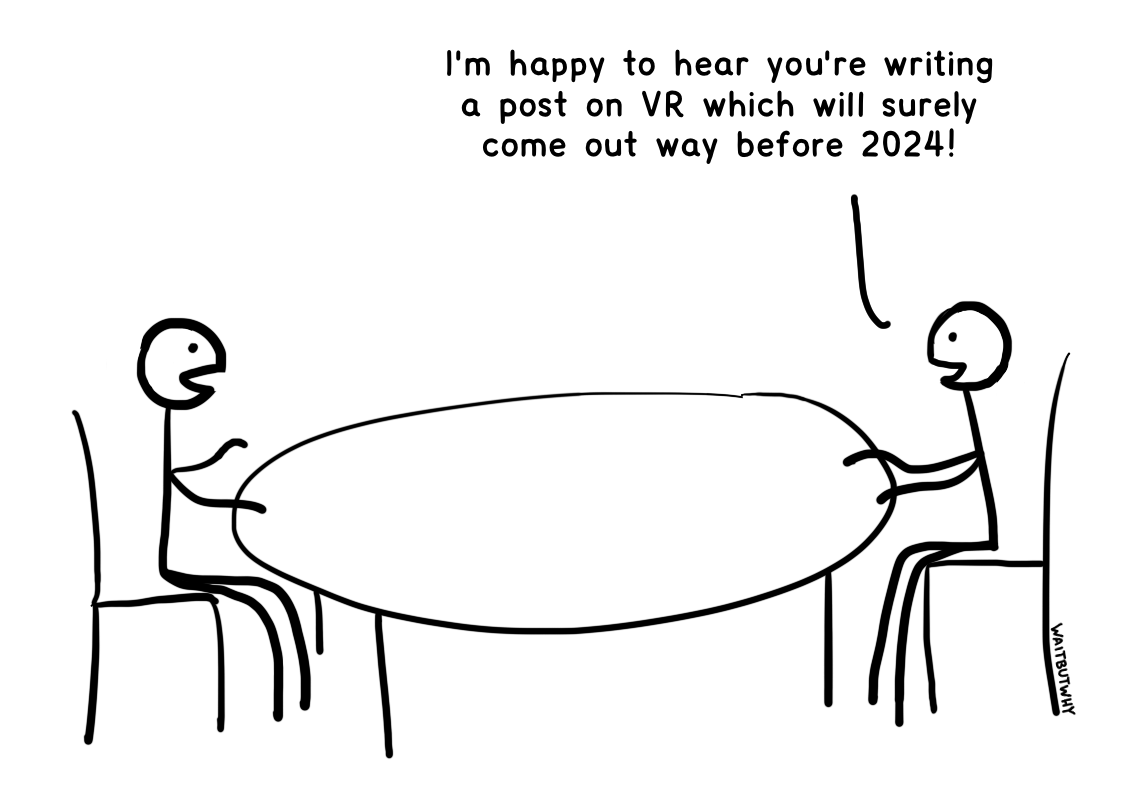
I demoed everything. It was mind-blowing. VR was about to take over the world. And I was gonna be the one to tell everyone.
Then two things happened:
From the bottom of my book hole, I kept following the story. At Facebook’s 2016 developer conference, Zuckerberg had demoed a new bleeding-edge kind of “standalone, inside out” headset. Up until then, there were two ways to do VR: The first was with a cheap headset, maybe using your phone as a screen, that could do primitive head-movement tracking but had no way to see the environment around you. The second was with external sensors on the walls and a headset that attached to a high-powered PC with a cord. “Standalone” meant the new headset would have the computer inside, with no need for a cable. “Inside out” meant the headset could see the room around you, so you didn’t need external sensors. In 2016, this was just a prototype. Three years later, Facebook launched Oculus Quest.
In 2020, standing around during Covid with my dick in my hand like everyone else, I got myself a Quest 2. It was amazing. I loved it. It was my daily post-writing reward activity. I made 3D art. I swam with whales. I went on cartoon vacations. I exercised by slashing music. I beat Trover.
Then, for some reason, I stopped. I can’t really explain why. I really loved being in the Quest 2. I recently dusted it off to give friends a demo and they were floored, reminding me how great it is. It just didn’t hook me. Maybe it was the solo aspect. I don’t have friends who do VR so there’s no one else to play with. Maybe it’s the friction. It’s minor, but charging the headset, putting it on, and creating a boundary1 is still a lot more friction than picking up my phone. Maybe my delight relied more on novelty than I realized.
It’s not just me. VR blows everyone away when they try it, but it seems to have a hard time hooking people for the long run. After a major wave of hype in the mid-2010s, VR receded into the land of subcultures.
And the question is: Is there some fatal flaw to the concept of VR that will always prevent it from achieving mass adoption? Or are we some tipping point away from VR exploding into the stratosphere like the computer and smartphone?
Everyone remembers where they were when they learned that JFK was shot, a man had landed on the moon, or airplanes had flown into the Twin Towers. I remember where I was when I saw Steve Jobs unveil the first iPhone.
I didn’t always like Apple. My family’s first computer was an Apple 2GS. But then, like many early Apple computer users, I became a PC person. I used an IBM ThinkPad in college and thought Apple people were annoying.
Then Steve Jobs came back to Apple and started Making Apple Great Again. My post-college music composing path forced me to get a 2004 PowerBook G4. After getting used to the interface (why the fuck is there no start button?), I realized that Macs were amazing, and I’ve been an annoying Apple person ever since. But it wasn’t until 2007 that I became a fanboy.
In the presentation, when Jobs did the world’s first “swipe to unlock,” the audience made an audible gasp. A minute later, he brought up a list of artists in the phone’s “iPod” app and asked, “Well, how do I scroll through my list of artists? I just take my finger and scroll.” Another audible gasp. It’s weird that something so normal today was jaw-dropping 17 years ago.
The feeling I had watching that presentation had happened before. I felt it when I was five years old and tried Nintendo for the first time at a friend’s house (I can make something on the TV move by clicking this button??). I felt it in the early ‘90s when my friend showed me how to send an email (You can type something on your computer, hit a button, and it shows up on mine??). I felt it the first time I test-drove a Tesla (Why is this car accelerating so futuristically?).
I’ve learned to see a lot of meaning in these holy shit moments. In most cases, they’ve been followed by an entirely new industry sweeping the world—like the smartphone, video game, internet, and electric car revolutions.
In June 2023, Apple announced the VR—sorry, spatial computing—headset that had been long rumored: the Vision Pro.
I watched the presentation, but it wasn’t quite like my experience in 2007. First, I had gotten excited about VR multiple times in the past and ended up disappointed. Second, unlike demoing an iPhone, watching a VR demo on a 2D screen just doesn’t show you what it’s actually like. Oh, also, it was $3,500. I happily shelled out $600 for the first iPhone. But $3,500? For a V1 product that will get way better (and cheaper) in the next few years? When I already have a Meta Quest? Nah. I might be a fanboy but I’m not a chump. It was the obvious grown-up decision to wait it out. Then I ordered one in the first minute after preorders started.
This Monday morning, I went to the Apple Store to put the Vision Pro on my chump face for the first time. The staff member guided me through a demo. And there it was: the holy shit moment.
But it was a holy shit moment with an asterisk. I had experienced full holy shit moments both in 1990 and in 2016 with VR, and these were the notable exceptions to the “holy shit moments are a surefire omen of an industry about to blow up” rule. Was this time different or would history repeat itself?
What I did know was that it was finally time to write a VR post. I wanted to post this week while everyone was hyped up about the Vision Pro. But I didn’t want to write about it before I had used it a lot, so I could experience not only the honeymoon phase but also what it was like to get thoroughly sick of it.
The plan was clear. I went home, told my wife that I would be deeply ignoring her and our baby for the week, and spent twelve hours a day in the headset for four straight days. I’m writing this on Thursday afternoon, having already logged over forty hours. Here are my thoughts.
There are three elements of any VR system: hardware, operating system, and applications. Let’s talk about each.

Apple Vision Pro (AVP)1 is heavy—a decent amount heavier (650 grams) than Meta’s Quest 3 (515 grams). It comes with a fancy band that goes on easily and you tighten with a little knob. It’s awesome. For 12 minutes. Then it started killing my face. With 3,500 regrets, I switched to the other band it comes with, which includes a loop that goes over the top of your head, and thank god for that because it was way better—so good that I am shocked to say that even at the end of a full day wearing it, I didn’t feel a euphoric “ahhh” relief taking it off. At least right now, it seems only a little more uncomfortable than wearing over-ear headphones for long periods of time. This might not apply to everyone, but I have not felt nauseous once while wearing it.
That doesn’t mean there’s nothing that sucks about wearing it. The “field of view” isn’t great, meaning there are thick black walls where your peripheral vision is supposed to be, which is a bummer. I can’t imagine it’s great for your eyes. And there’s no way around the fact that you feel like an asshole when other people are in the room.
There’s an external battery pack that connects to the headset with a cord and typically lives in my pocket. The battery lasts about three hours, but you can plug in the battery to make it last forever, like a computer if the battery only lasted for three hours. (You’re often using it in conjunction with your computer, which makes it a non-issue because you can plug the battery into the computer.)
When you put the headset on, it does the AVP version of Face ID: scanning your irises. This is seamless and very futuristic. Then, you see exactly what you saw before putting the headset on. Lots of reviewers have marveled over AVP’s “pass-through” capabilities, and the second I put it on, I understood why. While it’s not perfect, it’s almost like you’re wearing a transparent snorkeling mask. The headset is in fact opaque—cameras on the outside transmit the world onto screens on the inside. But the screens are so good and the latency so low that it really seems transparent. Then there’s the much less successful attempt to make it look transparent from the outside as well, using cameras on the inside to broadcast your eyes onto the front of the headset. The goal is that if you’re talking to someone while wearing the headset, it feels to both people like you’re wearing a transparent snorkeling mask. But at least in V1, the eyes don’t show up nearly as well as advertised.
The internal screens save energy by doing something clever called “foveated rendering”—i.e. only putting the exact place you’re looking in perfect focus while making the rest of the view lower-res. This is what your actual eyes do, which is why your peripheral vision is blurry. If you watch this viewcast I made, you’ll see that most of it is blurry (the sharp part was where I happened to be looking while taking it)—but as the person in the headset, I only ever saw perfect sharpness.
The way Vision Pro does audio is also cool. There have always been two sound options for me while on my phone or computer: play from the speaker and everyone can hear it or put on headphones and no one can hear it. AVP speakers are somewhere in between. The speakers (which sound great) are small and right above your ears, and while people right next to you can hear what you’re hearing, people in the next room cannot. So in a coffee shop or on an airplane, you still need headphones, but I do a lot of my work in an office in our house with the door open, and it’s been nice to work both without headphones and without bothering anyone in the other room.
This was the biggest holy shit of my holy shit moment. Apple is the king of simple intuitive interfaces. Part of what drew those gasps in 2007 was how natural the iPhone’s interface was. You scrolled down by pushing the page up, just like you would in real life. You zoomed by pinching with two fingers. It seemed like magic. AVP’s interface is gaspworthy for the same reason. The main gesture is what I’ve been calling the “eye pinch.”
When you press the button at the top of the headset, your apps come up, floating in the room in front of you, looking as real as any other object in the room. They’re fixed in space. You can walk right up to them, and the detail is amazing.2
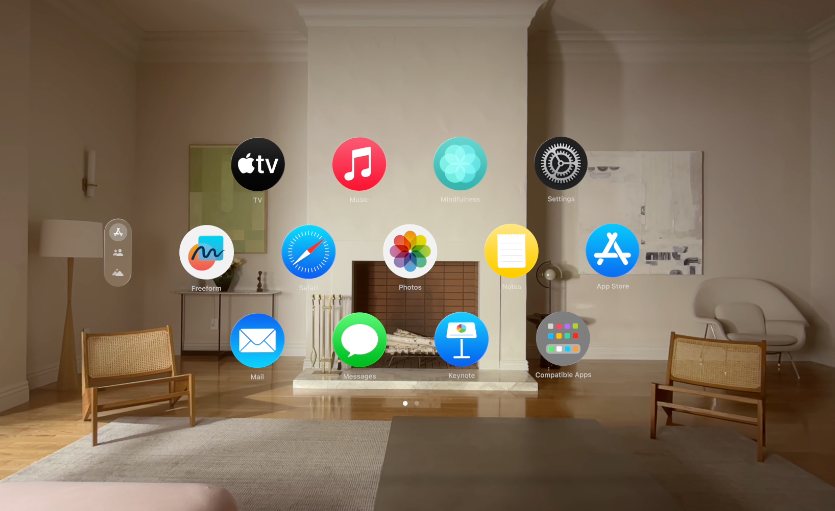
Vision Pro’s eye tracking is outrageously good. It knows precisely where you’re looking. So all you do to select an app is look at it and tap your thumb and index finger together. Your hand doesn’t need to move up to do this, just somewhere the headset can see it. Watching the ads, it seemed like this might be annoying to do, but it’s every bit as easy and intuitive as opening an app on a smartphone.
No matter what you’re doing, the eye pinch is the equivalent of touching a finger to a smartphone screen. To scroll, look anywhere in the window, pinch, and move your hand up. To move a window, look at the little bar below the window, pinch, and move it where you want to. To resize the window, look at the window’s corner, pinch, and resize.
As John Gruber put it in his review:
The fundamental interaction model in VisionOS feels like it will be copied by all future VR/AR headsets, in the same way that all desktop computers work like the Mac, and all phones and tablets now work like the iPhone. And when that happens, some will argue that of course they all work that way, because how else could they work? But personal computers didn’t have point-and-click GUIs before the Mac, and phones didn’t have “it’s all just a big touchscreen” interfaces before the iPhone. No other headset today has a “just look at a target, and tap your finger and thumb” interface today. I suspect in a few years they all will.
Then there’s the fact that everything you see in front of you is available desktop to work with. On my computer, I’m used to my applications being stacked, and I toggle between them. Or maybe I put a few vertical windows side by side. In AVP, I can put one eight-foot window in front of me, two more on either side of it, and a couple more above them in the sky. Then, if I get up to go to the other room, the windows all stay exactly where they are, waiting for me to come back. If I want to switch work spots, I just hold the headset button and the whole configuration jumps to the new location. This is all way cooler than I’m making it sound, so I made a video to show you how it works:
One thing you’ll notice in the video is that I routinely spin the digital crown on the headset to slide between being entirely in reality, partially in reality, and entirely in a virtual landscape. This is ridiculously fun to do. And it’s a general reminder that AR and VR2 being separate categories is a thing of the past. In the Vision Pro, the Quest 3, and any future headset, you can be 100% in the real world (when there’s nothing on the screen and it seems like you’re wearing a snorkeling mask), you can be mostly in the real world except there’s a virtual game board on your kitchen table or a little virtual butterfly fluttering around. You can be halfway between reality and virtual when, say, portals open up in the walls around you during a game. Or you can go full virtual.
There are many categories of spatial computing apps—productivity, entertainment, social, gaming, creative, fitness—and for most of them today, you’ll need a Meta Quest or some other non-Apple headset. There are a small handful of astounding apps for AVP, but they’re more a sampling of what’s possible than an actual app store.
The most “you can absolutely not do this anywhere but a VR headset” thing I did was their little taster menu of immersive entertainment. Entertainment on a headset runs on a spectrum of immersion. The least immersive is watching a normal movie on a massive screen in a virtual space like the moon or a giant theater. Those movies you missed that everyone says are best seen on the big screen—you can see those on a big screen now.
Next are movies that are framed in a normal rectangle, but they’re 3D looking—like when we used to wear those stupid paper glasses but much, much better. Sometimes, these surprise you when something comes out of the screen to fly through the air or stand on the floor between you and the screen. The AVR comes with one of these—“Encounter Dinosaurs”—and it’s delightful.
Finally, there’s full immersion, where the scene entirely surrounds you and you actually feel like you’re there. These are better described as “experiences” than “entertainment.” I saw rhinos up close in person last year. Then, this week, I did one of the Vision Pro experiences that’s an up-close hang with rhinos. These two experiences were very similar. Another experience lets you sit in on an Alicia Keys rehearsal where she sings some songs standing two feet away from you. You can watch her for a while, then look over at what the drummer or keyboardist is doing for a while—just like you would if you were actually there.
Photos and videos are also cool. When you take a panoramic photo, you sweep your phone around in a C-shaped arc—but on a flat phone screen, the result is a flat photo. In AVP, panos are C-shaped, like the photo you actually took. The C wraps around you, which I quickly learned brings the memory back way better than the flat version. You can also turn the headset into a camera and record photos and videos, both of which are immersive. When you later view them in the headset, they’re 3D, putting you right back into the actual scene.
Then there’s the infamous Vision Pro avatars. You get one of these by flipping the headset around and letting it take pictures of you from different angles. Then when you FaceTime someone, your avatar mimics whatever facial expressions you’re making. Here’s mine:

The first person I tested it out on was my wife, who immediately gasped in horror, saying I had “little uncanny valley snake eyes rolling around in my skull,” whatever the fuck that means.
The uncanny valley she’s upset about is this:3
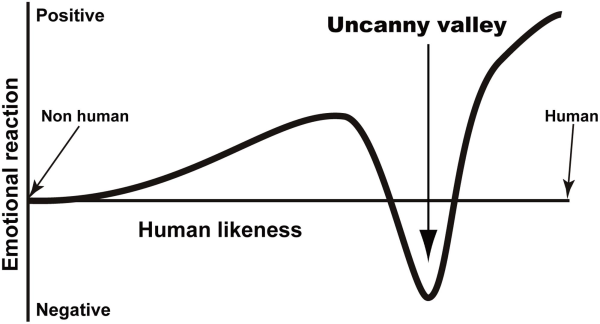
The idea is that we like faces that are somewhat humanlike, and we like faces that are totally humanlike, but we hate faces that are almost-but-not-totally humanlike. Faces that fall just short of being human give us the collective willies.
Avatars used to suck. Then they got better. Now they’ve gotten so good they’ve plunged into the uncanny valley. This was always gonna happen at some point on the road to perfect avatars and that time is now.
To test it out for myself, I FaceTimed my friend Jules Terpak, who also has a Vision Pro. First I put her across from me at this table while we sat around with each other’s uncanny valley faces for a few minutes.
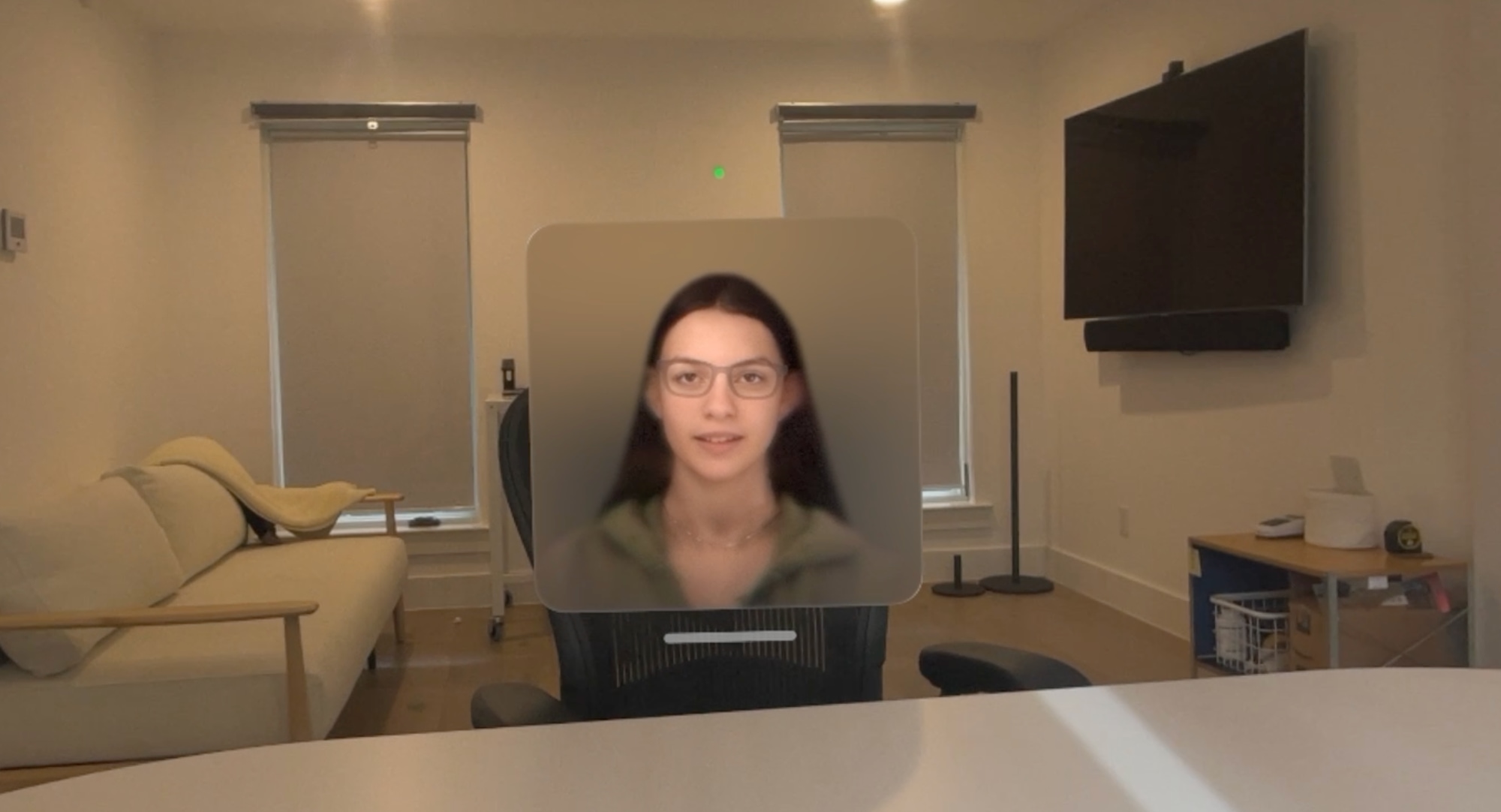
One very cool thing is that when I moved her window to a different seat at the table, her voice shifted locations to that spot. We concluded that this activity was not actually an upgrade over FaceTime, but that if there were more than two people, it could feel like everyone was sitting around a table together, which would be better than talking to a group FaceTime or Zoom.
Then we shifted locations to Mount Hood.

This felt more like we were actually hanging out somewhere, which is an effect you can’t get on FaceTime.
When we started going into apps together, it felt even more like we were actually doing an activity together, in a way you normally can’t do without being in person.

It’s very crude right now, but it’s a primitive version of something we’ll probably all be doing constantly in the 2030s. It’s the next step in a centuries-long human mission to conquer long-distance. First there were letters, then phone calls, then mobile phones3 and video calls. The next step is VR hangouts.
By far the thing I spent the most time doing in the Vision Pro was exactly what I normally do, but the AVP version. When you’re sitting down in front of your computer while wearing the headset, you can open your computer screen as a giant virtual window (which you still control with your normal keyboard and trackpad). Whatever screen you’re used to working on is now much, much bigger. It’s also much more mobile. I don’t usually work on the couch because I prefer my big monitor over my laptop screen. This week, I spent a lot of time working on my couch on a 100-inch monitor. I don’t normally work lying flat in bed because the laptop screen isn’t directly above me. This week I did, putting the screen up on the ceiling. I did some work outside on the porch and some more under a tree. Sometimes I saw the room around me, only with a big screen floating in it. Other times, I went fully immersive, writing on a mountain top, a sand dune, or the moon. And as I mentioned at the beginning of the post, I’m currently using the AVP in a coffee shop, which is officially embarrassing.
For some odd reason, you can’t open multiple desktops (yet), but you can open some of the things on your desktop as their own apps in separate windows. There’s an AVP iMessage app, so I closed iMessage on my desktop and opened it in an adjacent window. I often remotely cowork with Alicia (WBW’s Manager of Lots of Things), putting her in a little window in the corner of my screen. Now, she’s in her own window. If I’m willing to bite the bullet and switch from Chrome to Safari, I can pull my research and web browsing off the desktop too. The end result is that a single small, immobile computer screen has been replaced with a giant mosaic of screens, for the small price of having a snorkeling mask on my face all day. It kind of feels like you stepped into your computer screen, into the beautiful wallpaper landscape, amongst the windows. Very surreal. I wrote this entire post in the headset and have found myself enjoying writing more—and being more focused—than normal.
The best way I can describe how I feel about the Vision Pro is a strange combination of utterly thunderstruck and mildly underwhelmed.
The magical interface, the giant screens, the immersive experiences—they’re just unfathomably cool and awe-inspiring. It feels like a sneak peek at the 2030s.
But after a couple of days, I found myself thinking, “Is that…it?” I had done the small handful of immersive experiences, played some of the small selection of games, looked at a bunch of my panoramic photos, and tried avatar FaceTime—and at the moment, there’s just not that much else to do in the Vision Pro.
The first iPhone left me feeling the same combination of blown away and bored. The phone and I had a torrid honeymoon, but after the novelty of the interface wore off, all it had to offer was the same 16 practical apps.
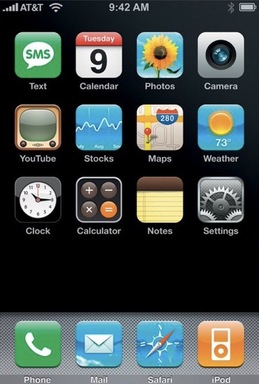
There was no app store yet, it dropped calls constantly, and the cellular internet (which you couldn’t use while on a call) was painfully slow. The iPhone wasn’t a world-changing device yet. It was the seed from which a world-changing device would grow.
If you zoom out on a story of technology, you usually see a big exponential curve.

But if you look at the curve up close, you see that it’s wavy, made of S-curves.
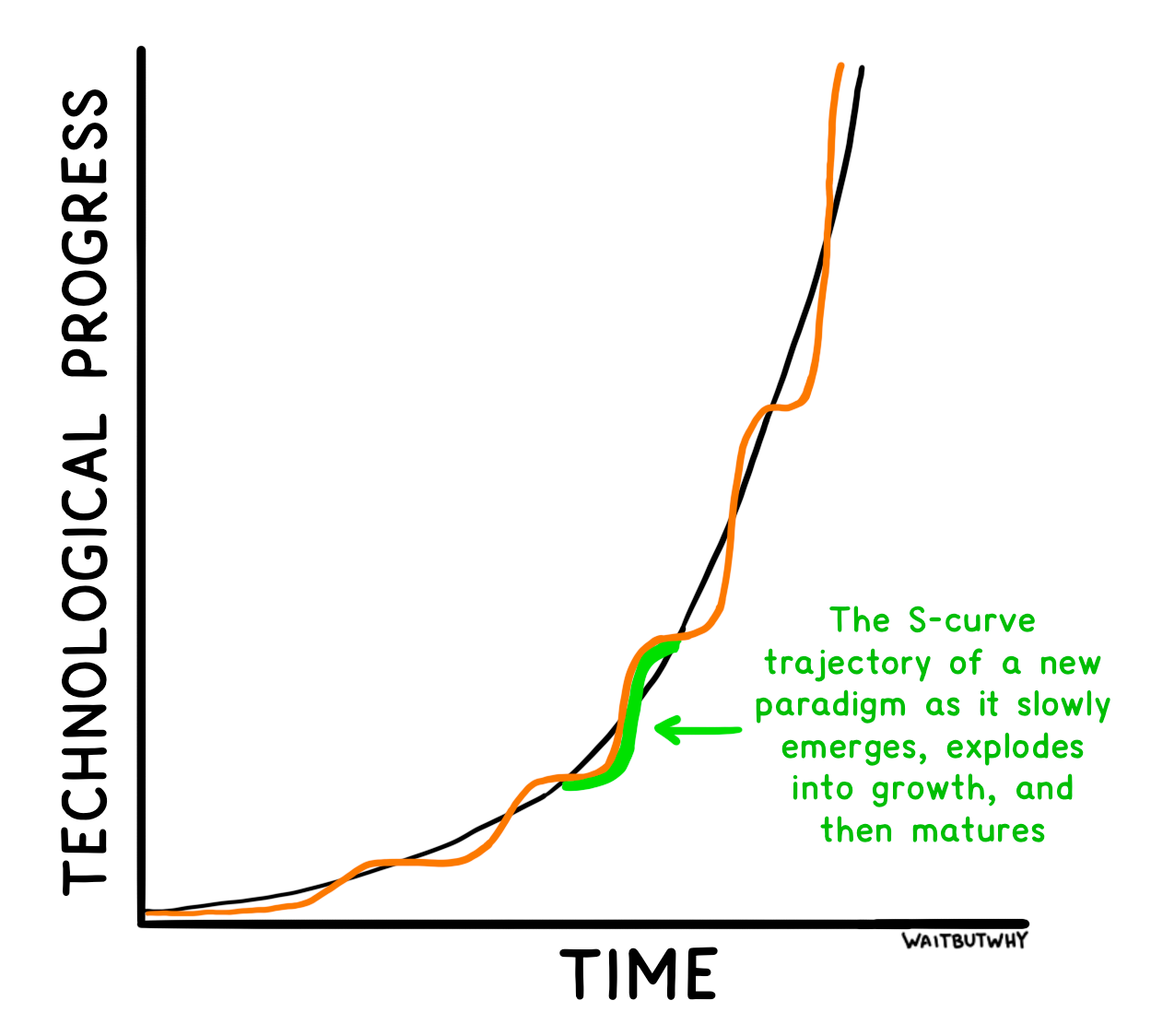
The first iPhone was such a big deal because it launched a new S. Investors had a new place to pour their money. Developers had a new place to pour their efforts. Creators had a new place to pour their talents. As millions of human hours worked on the collective human project, the next five years were a whirlwind of innovation and excitement. Apple’s keynotes became a must-watch for anyone interested in tech, as each jump between the iPhone 1 > 3G > 3GS > 4 > 4S > 5 was a major leap in hardware and software. It was the steep part of the S.
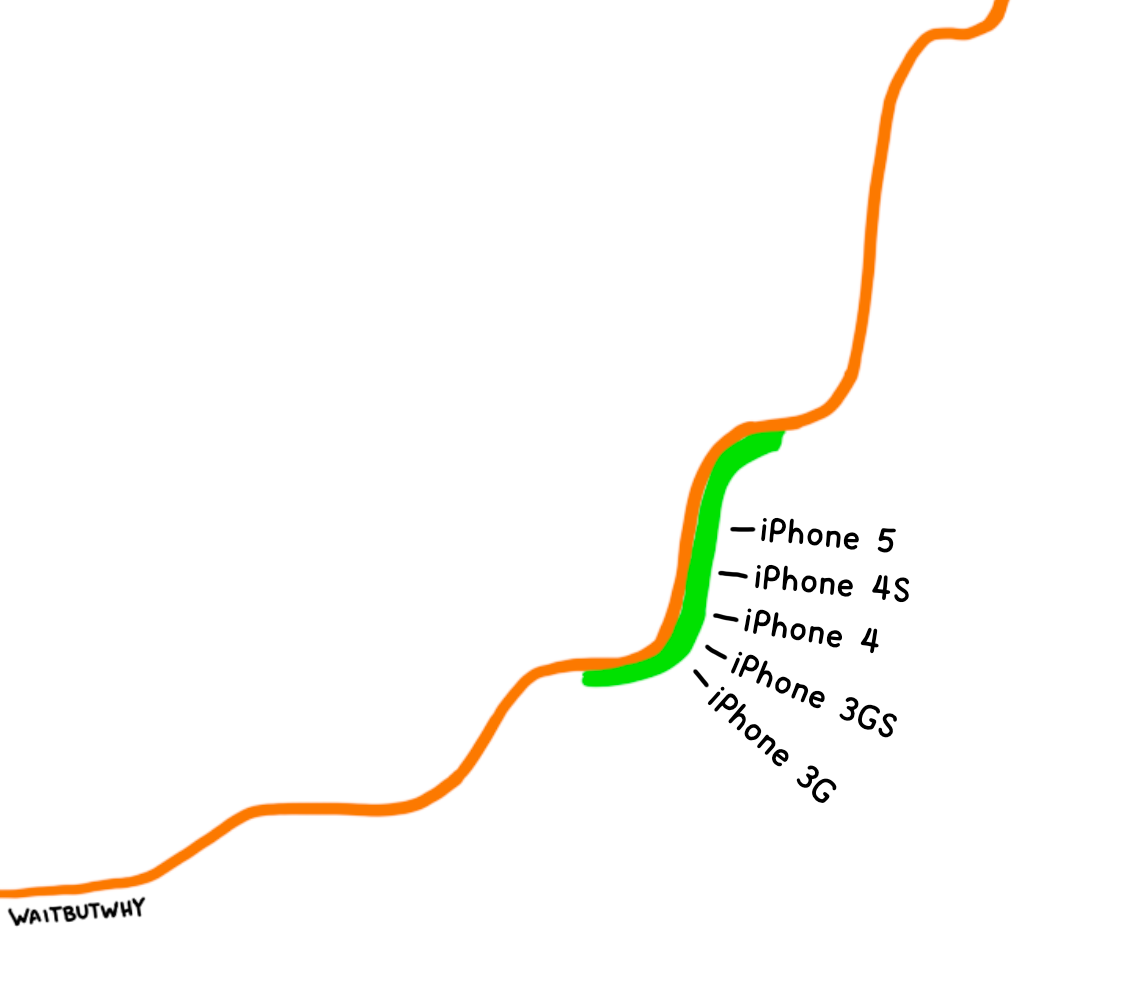
Then, the keynotes got boring. The changes were incremental. Apple stopped innovating and started refining. This coincided with Tim Cook taking over, but it isn’t his fault. The steep part of the S-curve doesn’t go on forever, and companies often reap the biggest rewards in the boring, top part of the S once the industry matures.
Maybe the reason VR has been slow to take off isn’t because there’s something fundamentally wrong with VR. Maybe it’s because, for the last decade, we’ve been working our way through the very early part of the VR S-curve—the slow part where foundational technology is researched and built. My Vision Pro is highly imperfect—overpriced, heavy, slightly glitchy, very limited, creepy-avatared—because that’s exactly what products are like at the bottom of the S. Consumer products aren’t ready for mass adoption during this stage. But it’s the breakthroughs made during these years that set the stage for the explosive exponential phase of the curve.
The lesson from past VR hype cycles is to temper expectations. The VR S-Curve explosion may be many years away or never come at all. But the lesson from past Apple launches is don’t bet against Apple, and Apple’s bet is that the Vision Pro could be a seed like the first iPhone—a platform for innovation that kicks a new S-curve into high gear.4
For someone to regularly use a piece of technology, the benefits have to outweigh the costs. Right now, the Vision Pro benefits are probably less than the costs.
I’ve already paid for mine, which removes one of the costs, and it’s still a question to what extent I’ll choose it over my computer in the long run. In that regard, the AVP might currently be more like those first cell phones you had to carry around with a briefcase than the first iPhone. Would you get a cell phone if the only way they came was attached a briefcase? Maybe, but it’s a close call.
For VR to achieve mass adoption, the good needs to be better and the bad needs to be less bad. It’s easy to imagine a pathway to both.
The operating system will get better each year. The two-finger pinch is currently the only gesture. More will be added. Eventually, there may be dozens of ways to make gestures with our fingers, each one a different command, like today’s keyboard shortcuts. When you spend ten minutes setting up an elaborate configuration of windows, you’ll be able to save (and share) it.
Avatars will go from uncanny valley to indistinguishable from your normal face. When you go into immersive environments, you can currently see only your hands. In the future, you’ll be able to identify other objects to remain visible (like a coffee mug). The environments around you will expand from the six current options to hundreds, including delightful fantasy worlds, and they’ll be interactive, allowing you to change things like the weather.
The hardware will get continually smaller and more comfortable. The resolution and frame rate will become as advanced as the latency. The battery will get way better. So will the look from the outside: to people in the room, the headset will come to look totally transparent. (My personal fantasy: The computer itself becomes detachable, allowing the headset to be a light, sleek, cool-looking visor. The computer and battery snap together into something the size of a smartphone. You’ll be able to snap it to the back of your visor if you don’t want the cord, but most people will prefer the weight to be somewhere other than their heads. The computer/battery rectangle will also have a screen and function as a smartphone for times when you want to do something with the visor off. The visor will fold neatly onto the rectangle to make the whole thing a single compact object.)
Finally, the amount of content, applications, and experiences will multiply by 1,000-fold, just like the apps in the app store did from 2008 to today. There will be a wide array of immersive games and entertainment. People will watch sports from one of many vantage points on the field, sideline, stands, or overhead—next to their friends, who will be able to look at each other and talk as well as if they were actually together in person. Pop stars will play in front of 50,000 people in person and 5 million people virtually. Fitness will become fun, interactive, and social. The best teachers and coaches will reach millions of people. Amazing AI teachers could reach billions. Distance will melt away, allowing people to spend high-quality time with their loved ones, no matter where they are. People who couldn’t dream of traveling the world today will get to enjoy vivid experiences anywhere on the globe. Of course, my silly 2024 imagination can’t scratch the surface any more than people in the briefcase phone days could have predicted Uber, TikTok, or Tinder.
Over time, the price will come down, with some companies making headsets dirt cheap the way they have for smartphones today. As the value proposition gets better and better, more people will have them, enhancing the social component and eradicating any stigma. Mass adoption seems like a very real future possibility.
I know what many of you are thinking: A world where everyone is in VR headsets (or visors, or glasses, or contact lenses) sounds dystopian and awful. And granted, this is coming from a guy who thought that world of glazed over people in moving chairs in Wall-E looked like a great place to live—but I’m excited.
K can I take this thing off my face now?
_______
What to read next:
A post about a technology even more intense than VR
A post about a different technology that’s also even more intense than VR
A post about a third technology that’s even more intense than VR
_______
If you like Wait But Why, sign up for our email list and we’ll send you new posts when they come out.
To support Wait But Why, visit our Patreon page.
When you use the Quest 2 in a new setting, you have to manually show the headset the boundaries of the open space you’re going to be using. This isn’t needed in the more recent Quest 3, which automatically maps out the space.↩
“Virtual Reality” has traditionally referred to totally immersive headset experiences. “Augmented Reality” is when you see the real world around you with virtual elements added in.↩
We’re so used to mobile phones that we forget how insanely cool they are. I can pick up my rectangle and instantly contact you wherever you are on the planet.↩
If this is what happens, unboxed first-generation Vision Pros will be auctioned for a ton of money in 2060. Just saying…↩
The post All My Thoughts After 40 Hours in the Vision Pro appeared first on Wait But Why.
2023-05-24 03:32:00
Back in February, I wrote a post about my upcoming book that included a big visual of the timeline. Just two weeks after the book launch, my first baby would be born. I’d promote the book, catch my breath, and then begin the new adventure.
Thank god for those critical two weeks.
The night before book launch was (obviously) a frantic all-nighter, and I eventually went to bed after 40 hours awake, exhausted and satisfied. We had done it. The book was live. It was over. I’d actually wake up tomorrow without this project hanging over my head. The sky would be blue. I’d finally be free.
I woke up close to noon and felt at peace for three seconds before opening my phone and seeing three texts from my wife:
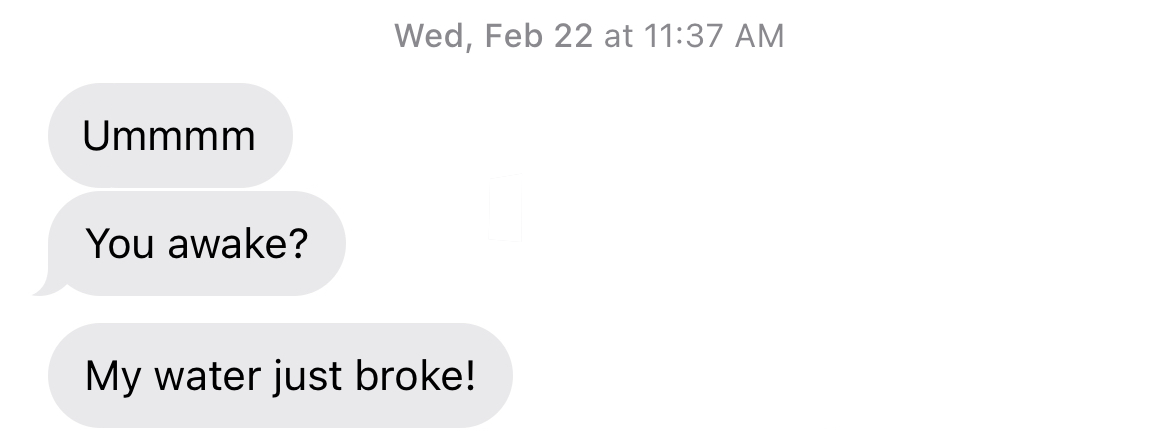
Hm?
I knew what water breaking was. But I didn’t know what it meant. Is the baby coming out now? Or was this one of the false alarms I had heard about and the baby is still a couple weeks away? Is there a chance she just peed her pants and is misdiagnosing the situation?
After some rapid-fire googling, one thing was clear: We had to go to the hospital. Now.
The drive was weird. I had pictured myself heroically driving a screaming labor-having wife to the hospital, but here I was driving normally to the hospital with a very normal wife next to me. Apart from her new leaking situation, nothing was different than it was yesterday. There was no way we were actually having a baby today. Right?
Upon arrival, the PA assessed things and yes her water had broken, and yes in order to avoid infection that meant the baby had to come out now. Two hours and 12 canceled book-promoting podcasts later, we’re in our delivery room, where my still-not-in-labor wife would supposedly be producing a baby sometime later today.
Again, there was a major expectations-reality gap. I had pictured the day of my first child’s birth being impossibly frenetic and emotional and intense. But there we were, eating animal crackers and gummies from the treats-you-can-eat-while-in-labor bag, hanging out and chatting like any other day.
My wife was hooked up to a bunch of tubes and machines and the plan was to see if contractions would start on their own as a reaction to her water breaking, but a few hours passed and nothing happened. Eventually, the nurse came in and poured a magical little chemical called Pitocin into her IV bag.
And things started happening.
Contractions began, which my wife described as “a really bad period cramp,” which helped me understand what they felt like 0%. Over the next couple hours they got worse and worse. I was quickly assigned the role of “don’t say or do anything” while contractions were happening, so I’d just kind of sit there awkwardly and watch with this face on:

Her epidural plan was something like “definitely get one but tough it out a little first,” and after a particularly awful contraction, she called it a day and the epidural team came in to do their thing. 45 minutes later, we’re back in the “I know this is the day of the birth of our first child but it sure doesn’t feel like it” zone, chatting and hanging out normally. After a few more hours, a nurse came in and checked on the dilation situation and was like “alright, let’s do this!”
Once again, nothing like I pictured. I thought there would be a big team of doctors and nurses doing a whole big hectic thing and I’d be standing somewhere on the side. Instead, it was me and this nurse, each holding a leg.
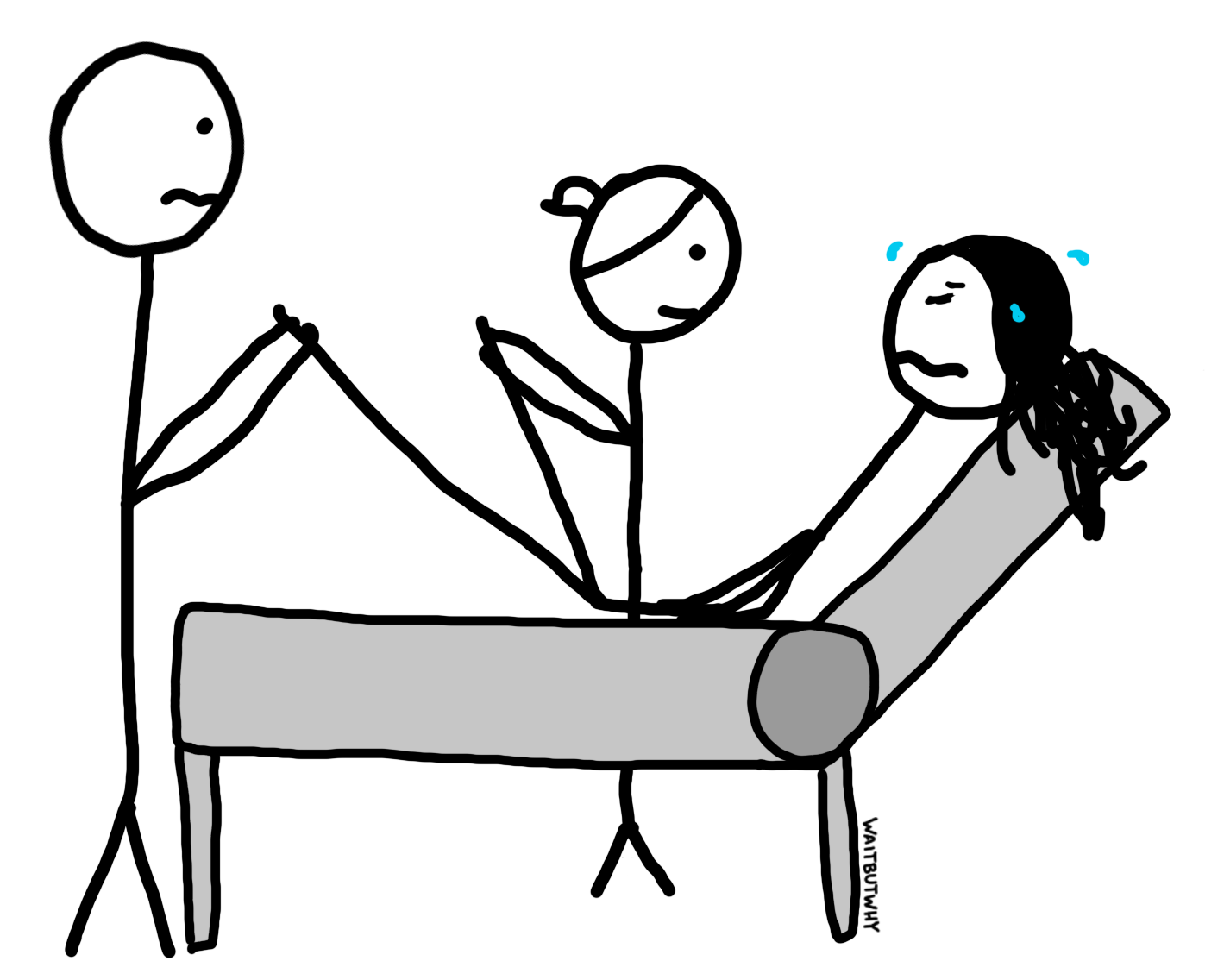
The game went like this: When a contraction starts, we each grab a leg and she pushes really hard for 10 seconds three times in a row. Then everyone chills and hangs out for a few minutes until the next contraction. And repeat.
After a few rounds of this, it was clear this was not gonna work. Nothing was coming out. But we kept trying anyway.
And then I saw it.
The edge of an upsetting slimy pancake.
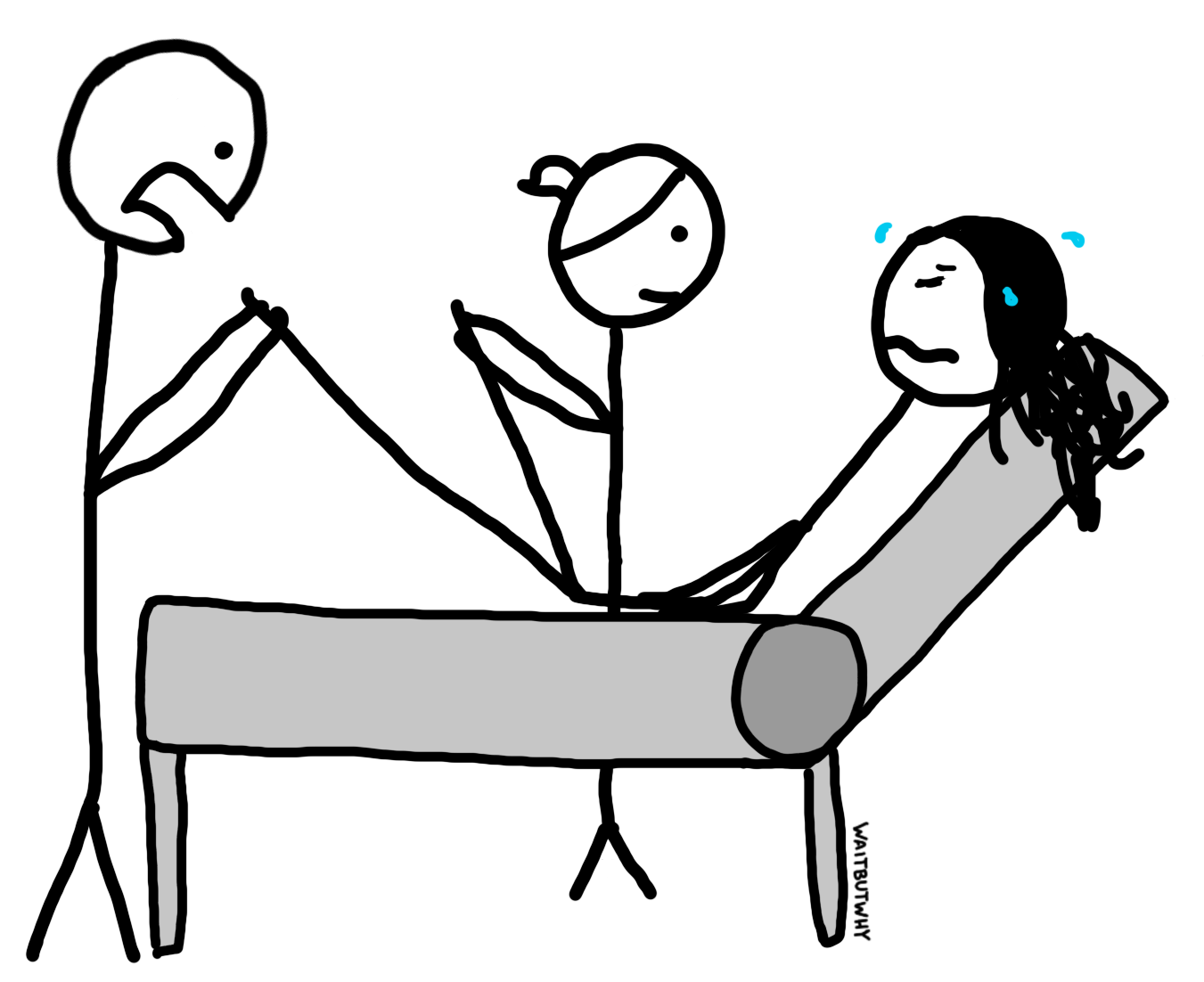
When I asked what the upsetting slimy pancake edge was, the nurse told me it was my daughter.
Uh huh.
This then went on for a while. We’d do a round of pushing, the upsetting pancake thing would come out a centimeter and then go back in, and each round it would come out a few more millimeters. It was increasingly feeling like we really weren’t getting anywhere with this strategy when the nurse suddenly says “okay let’s deliver a baby!”
She makes a call and a few minutes later a group of people come in, including the first doctor we had seen that day. The next contraction came along, I leg-held, my wife pushed, and then in the most surreal moment of my life, I was staring at a tiny screaming alien.
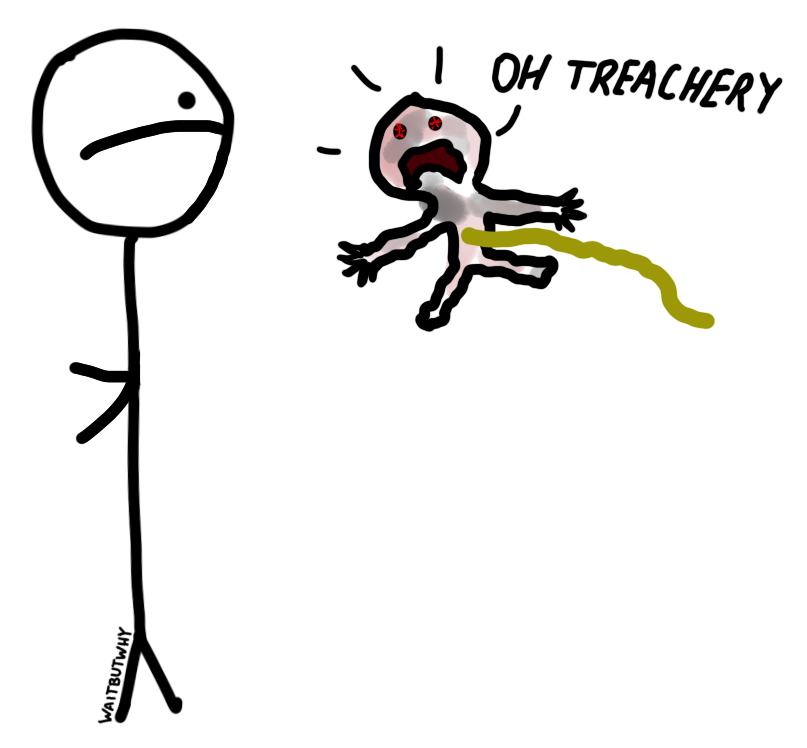
___________
That was 3 months ago. I’ve had a lot of thoughts since then. Here are 10 of them:
I thought it was gonna be like this:

But it’s actually like this:

A newborn is not a baby. Babies are cute and roly-poly and can see and are conscious and are normal and a newborn is not any of these things. It is a bizarre human larva that acts super weird and would still be in the womb if it could be. The problem is, when humans went bipedal, our pelvises got smaller, and as humans got smarter, our heads got bigger. So evolution had to get creative. Its solution: all human babies would be premies, born when they were still small enough to pass through a human pelvis. The last couple months as a fetus would happen outside the womb, and everyone would just have to deal with that. This became incredibly obvious during the first month with my daughter. She was a raw human id not remotely ready for primetime. Thankfully, since then, a baby has grown around the id and now she has the figure of a miniature 390-pound 84-year-old woman.1
If I want to drive a car, I have to take driver’s ed first. If I want to provide medical advice, I have to go to med school first. But after we had the baby, the hospital was like “don’t shake it k bye.”
I know a lot of words I didn’t used to know. Meconium. Tummy time. Latching. Bicycling. Swaddle. Colostrum. I know how many ounces of milk and hours of sleep the baby is supposed to have each day. I know baby CPR and the baby Heimlich maneuver. I know how to induce baby burps and shits. I know how warmly to dress a baby. I know what temperature baby bathwater should be. I know what sleep training is and when it’s okay to start it. I know that you can’t just pick a newborn up, you have to pick all the pieces up at the same time or else the pieces fall off.
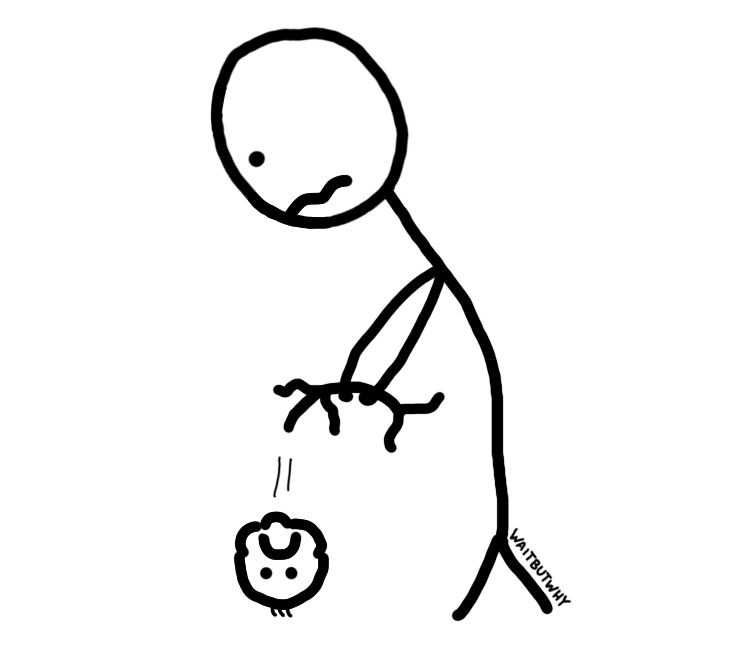
But I only know all of these things because I read books and articles and am fortunate to have people I can call with questions. And society’s current plan is to just expect/hope that every new parent does the same?? There should obviously be like a mandatory four-hour course every expecting parent has to take before they’re actually in charge of a newborn.
Instead, people like to say things like “you’ll figure it out” and “just use your instincts.” You could apply the same logic to driving and people probably would just figure it out—but we don’t do it that way, because that would be absurd.
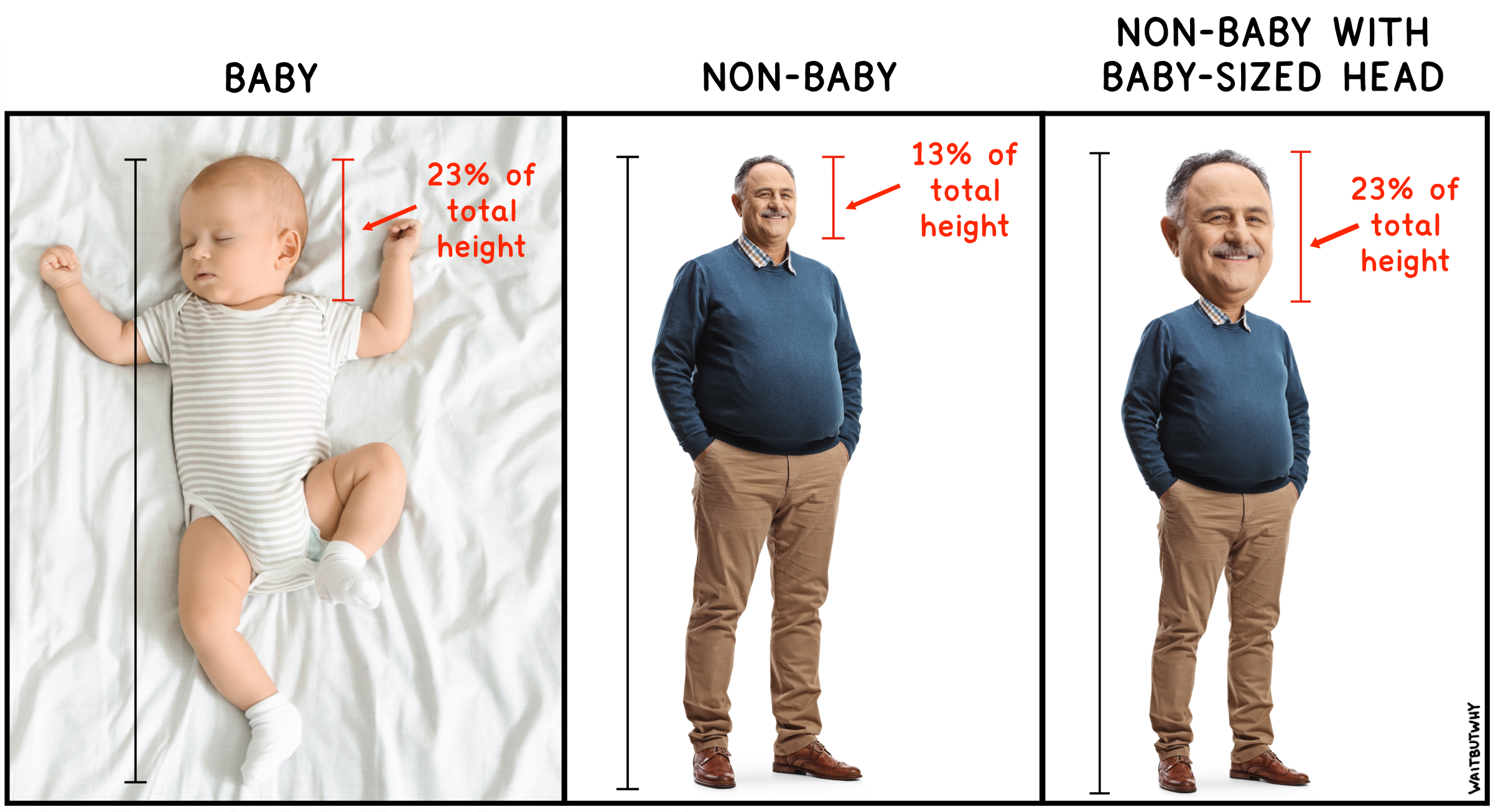
*I made this visual thinking it was gonna emphasize how big baby heads are, but after looking at the big-headed guy on the right for a while, it started to look normal to me, and the normal-headed guy suddenly looked like he had a ridiculously small head. So now I’m realizing that the big takeaway is that baby heads are normal and the rest of our heads are tiny.
When a normal person is hungry, or tired, or needs to burp, they’re a little annoyed. Babies are in Shakespearean agony. And then comes the burp and one second later they’re like “sup.” It’s insane behavior.
For a while, the range of baby emotion runs from Shakespearean agony to neutral, never entering the positive realm. Neutral is a newborn’s best-case scenario.

After six weeks or so, positive emotion begins to make an appearance, but then they still go apoplectic at the slightest inconvenience.2
While we’re here, I know it’s bad but I can’t help it—crying babies are funny. My wife completely disagrees with me on this.


It’s weird—you have all of these intense feelings for this little person* and there’s just nothing to do with those feelings. I could squish her face, but then she’d cry and I’d be abusing a baby. In the early weeks, there’s just not really a satisfying outlet for your baby fondness and it’s annoying.
One other one-sided thing is you’re apparently supposed to talk to your newborn even though they’re an unconscious fetus because it supposedly helps develop their brain. So now my baby has heard multiple versions of my next book outline, the full story of the rise and fall of the Assyrian Empire after I listened to a podcast about it, and a list of every World Series champion going back to 1990. Never once has the baby shown any sign of being affected by any of this.
*That said, I’ve always thought of parental love as the most intense form of love—the kind where if you had a Sophie’s choice where your baby and spouse were both hanging off a cliff and you could only save one, you’d save the baby without a second thought. And…yeah I’m not there yet. I love this little creature a freakish amount, but as of now, I’m definitely saving my wife in that situation. Sorry kiddo. I’m sure Tim the Baby-Saver-Wife-Dropper will at some point emerge, but I guess it takes some time.
Obvious one, I know, but just check this out:1

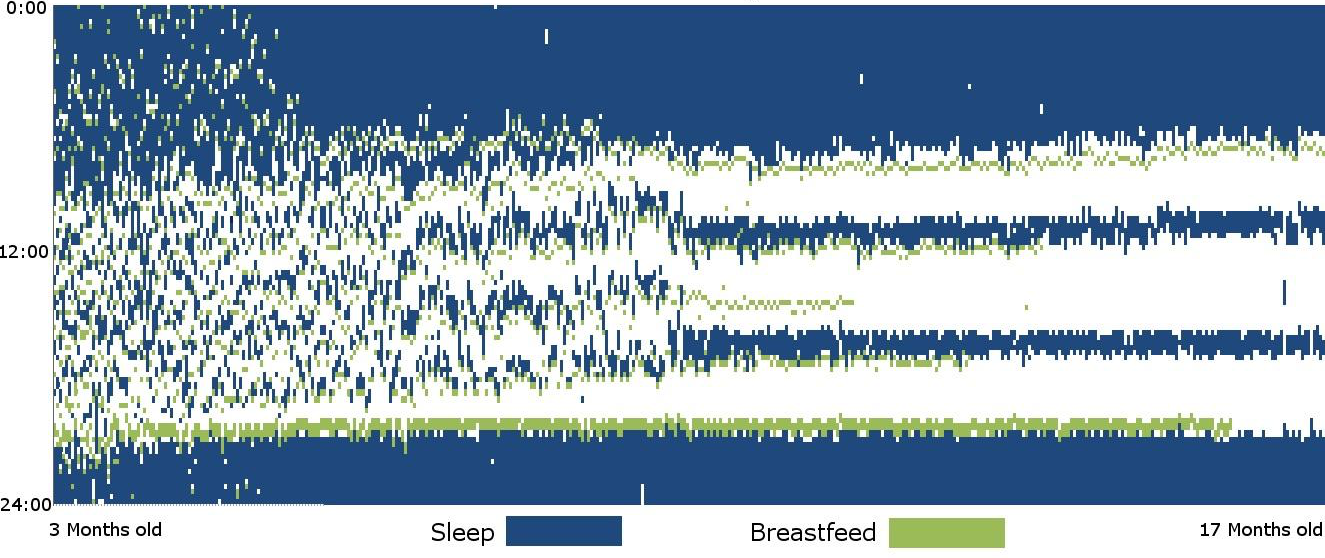

These are the sleep graphs of three different babies, but they all have one thing in common: there’s no rhyme or reason in the early months, because newborns are dicks.
I think my baby is impossibly adorable, of course, but every parent thinks that about their baby, so that offers no information. Everyone who has met her or seen a picture of her has commented on how cute she is, but they’d say that no matter what she looked like—which I know as someone who has commented on the cuteness of babies ranging from perfect to hideous—so there’s no information there either. FYI, I once depicted what happens when friends visit someone with an uncute baby:
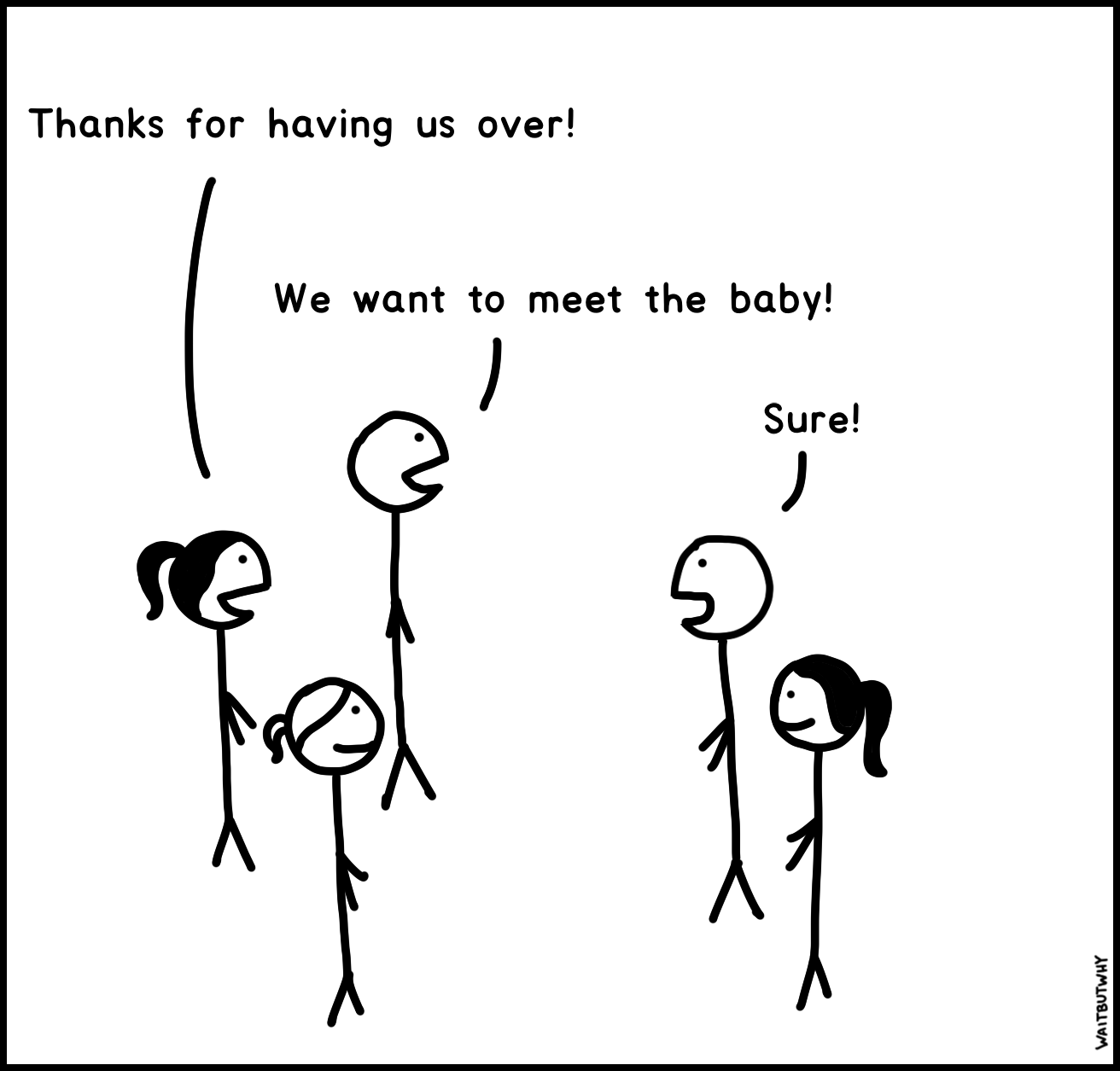
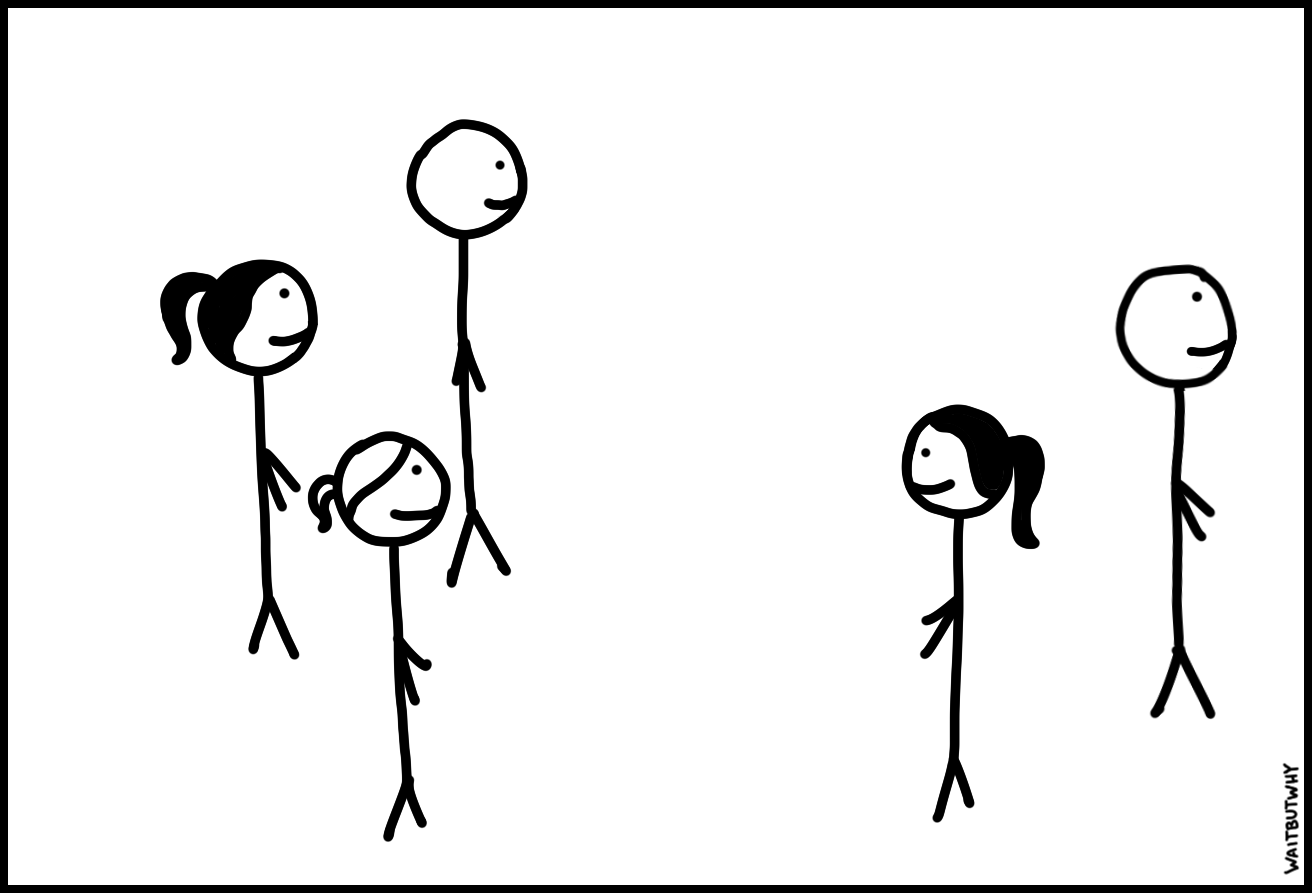
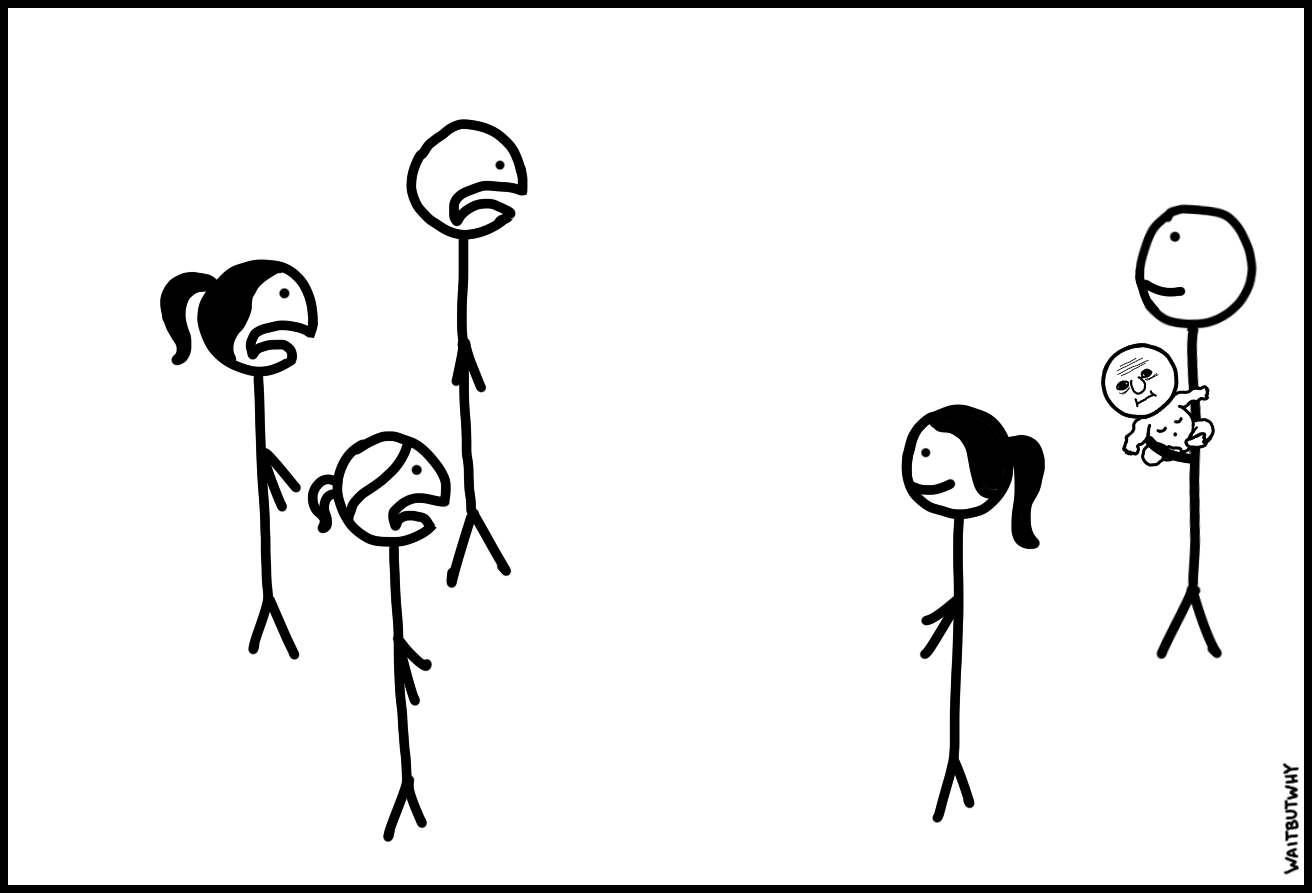
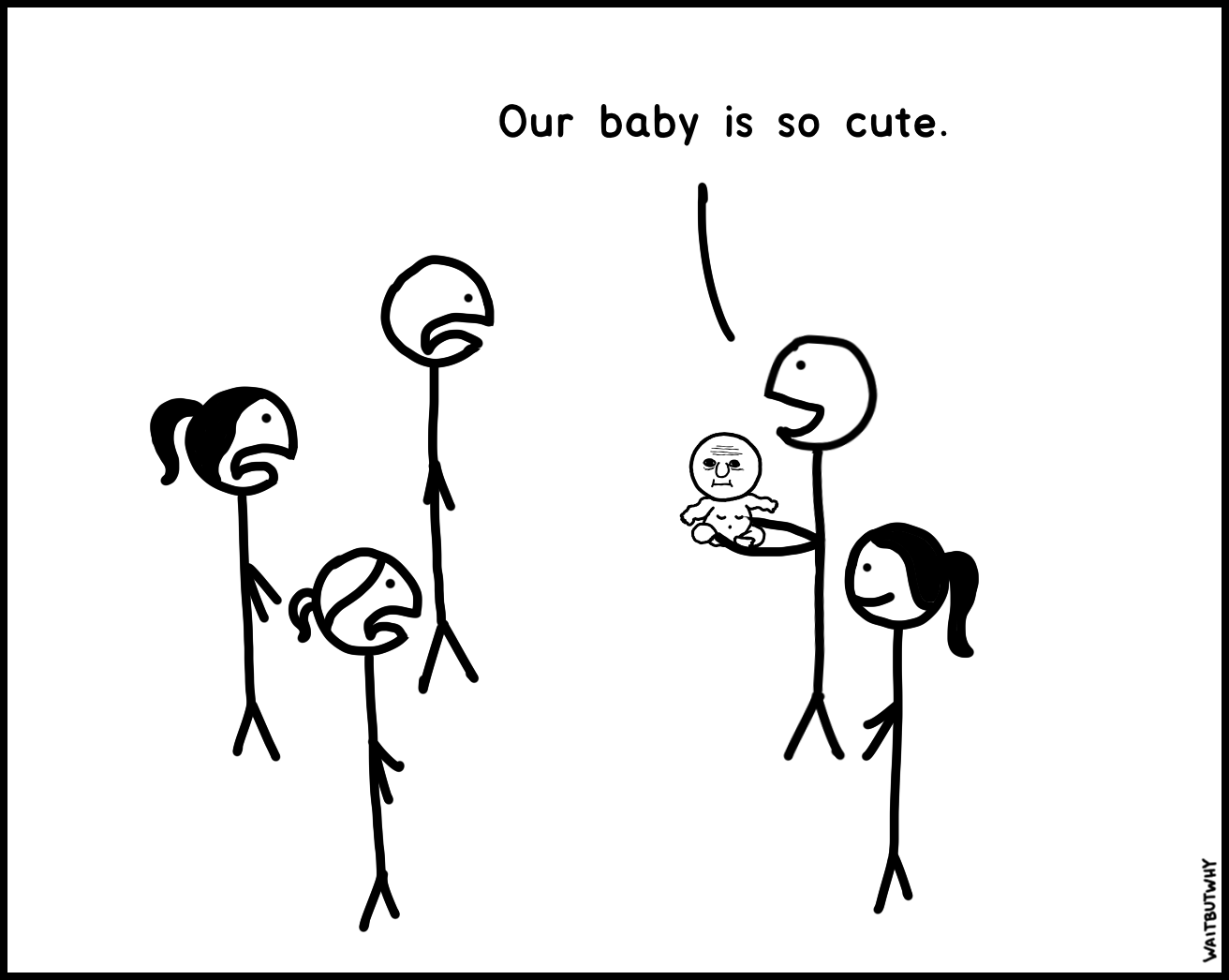
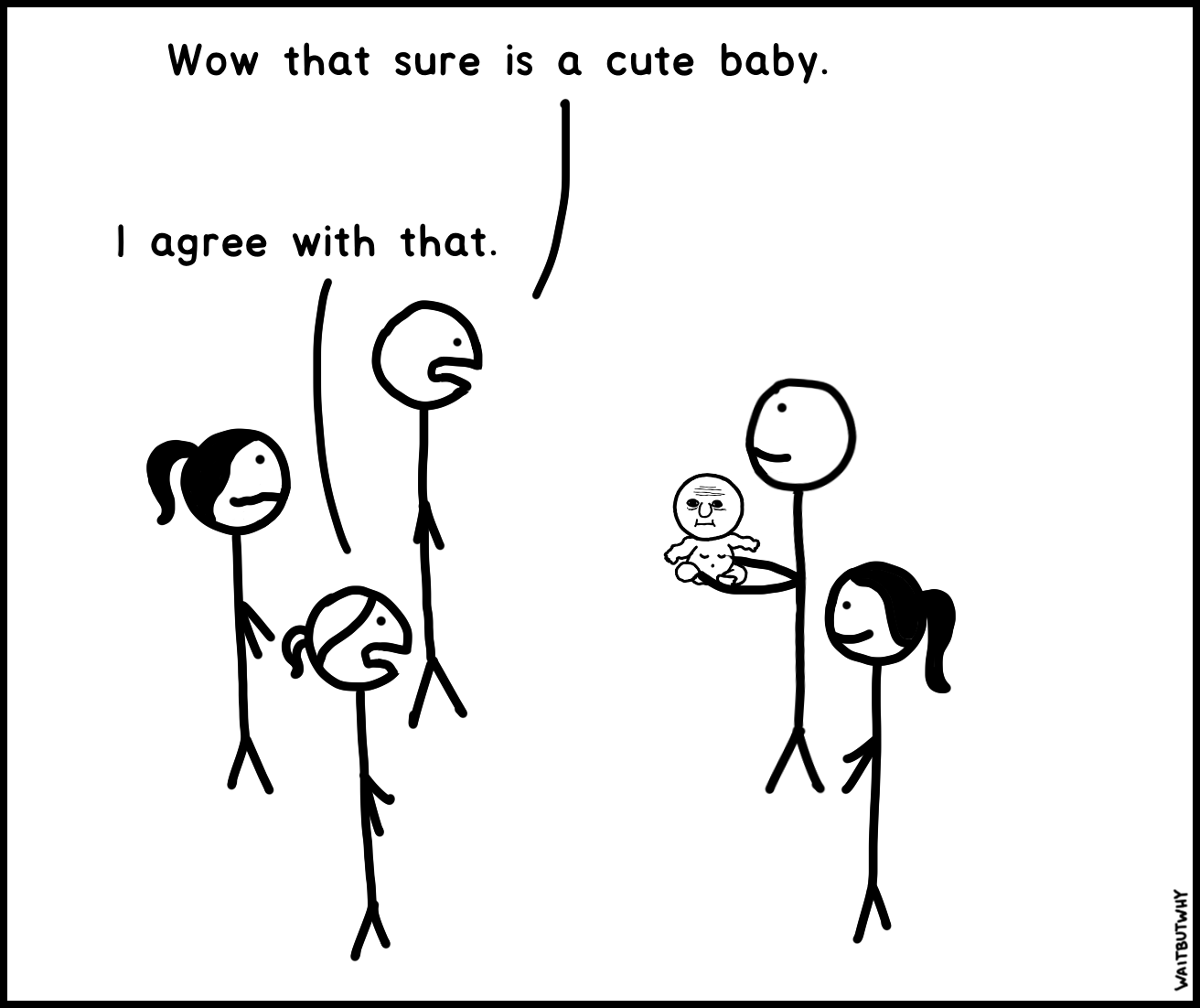
It’s pretty amazing how bad babies are at everything. They’re terrible at thinking, at knowing anything, at moving all parts of their body. The cool thing is that spending time with a super unimpressive baby has made me super impressed by myself. Like I’ll watch the baby sitting in a baby bouncer trying to reach for a little wooden flower one foot in front of her and she just flings her arm in the general direction and misses by a lot. Then I’ll reach for a glass of water and all of my joints work together to send my hand on a perfectly straight path through three-dimensional space, gracefully clasp my fingers around it using the perfect amount of pressure, raise it to my mouth, tilt it in perfect sync with the movement of my lips, and then return the glass to the table and gently place it down like an absolute genius.
Some things are just too big for our little human brains to fully absorb. The bigness of the universe. The permanence of death. The magnitude of the marriage decision, which I once described like this:
When you choose a life partner, you’re choosing a lot of things, including your parenting partner and someone who will deeply influence your children, your eating companion for about 20,000 meals, your travel companion for about 100 vacations, your primary leisure time and retirement friend, your career therapist, and someone whose day you’ll hear about 18,000 times. Intense shit.
A few months into fatherhood, this feels like another item in that category. When your baby is born, you will (hopefully) never live another day as a non-parent. For people who make the decision to do this, it is the BC-AD line of their life. It doesn’t mean you can’t still be you, but you are trading in one kind of life for another, with all of the pros and cons that come along with it.
I don’t think I’ve been able to quite wrap my head around the bigness of the situation. A curious childless friend asked me the other day if I feel like a dad, and I surprised myself by answering “not really.” I mostly feel like old me that has this new delightful little thing living in my house. When I see friends with sentient kids actually parenting them, saying things like “that’s not nice, stop it,” whatever that must be like is as much of a mystery to me as it was three months ago. For me at least, it seems like a parent is something you slowly turn into as your first baby slowly turns into a person.
Btw I’m now even more convinced than I was before that this is the most personal of personal decisions and no one should ever try to pressure anyone else to have kids—it’s way too big a thing to be anyone else’s business.
Every parent in history has brought their baby into a world with an uncertain future. But our future is the uncertainest. My baby might live a life a lot like mine, just a little more futuristic. Or she might live to 500. She might live most of her life with a brain-machine interface implanted in her head, thinking with her own superintelligent AI. She might suffer through civilizational collapse. She might live in a world that would seem like utopia to us today. She might live on Mars. She might meet aliens. She might die in the apocalypse. There’s just no way to know. It makes all of those fun, exciting, terrifying conversations about the future hit just a little harder.

_______
If you like Wait But Why, sign up for our email list and we’ll send you new posts when they come out.
To support Wait But Why, visit our Patreon page.
_______
More thoughts with comics:
10 Types of Odd Friendships You’re Probably Part Of
The Great Perils of Social Interaction
11 Awkward Things About Email
If you can’t decide whether to marry your significant other: The Marriage Decision: Everything Forever or Nothing Ever Again
If you’re hearing everyone talk about AI and would like an overview: The AI Revolution: The Road to Superintelligence
The post 10 Thoughts from the Fourth Trimester appeared first on Wait But Why.
2023-02-18 00:46:41
June 18, 2016. Obama was president, the Cavs were on their way to beating the Warriors in the NBA finals, Game of Thrones was still good, and I was 34 years old with my whole life ahead of me.
Wait But Why had been around for three years, a stretch during which I wrote about 100 blog posts on dozens of topics. On the afternoon of June 18, 2016, I was sitting on the couch engaging in a familiar ritual: looking through my list of future post ideas, trying to pick my next topic. And then I had a thought.
So many of the post ideas I was scanning through were about the future. Virtual reality. Artificial intelligence. Genetic engineering. Life extension. Multiplanetary expansion. But lately, it felt like there was a cloud hanging over all these topics.
My urge to write about the future comes from an excited optimism that’s fundamental to my personality. I believe at a deep level that the future is going to be an amazing, exhilarating ride, and nothing is more fun than learning about cutting edge developments that can offer clues into what magic might lie down the road.
But on June 18, 2016, I didn’t feel excitedly optimistic. There was a different feel to the world than there had been in my previous blogging years. Something seemed off about the society around me, like there had been a subtle, foreboding shift in the balance between reason and madness. It felt like we were losing our grip on something important.
The fun thing about being a blogger is you can write about whatever the fuck you want. And a good compass for me had always been that if something was incessantly on my mind, it was probably a good post topic. So I decided to write what I call a “mini post.”
Wait But Why articles are long, and they go deep. I bathe in the topic for a little while, dread writing it for a little while, then finally pump it out, draw the drawings, give it a read, and post. A mini-post is much chiller—I just open WordPress and type what’s on my mind, and post it.
So I opened WordPress to write a little post about that cloud I felt hovering over my other post topics. I’d knock out a draft tonight, give it a read tomorrow, and publish it.
But nothing came out. I didn’t know where to start.
There were a bunch of bad trends: Tribalism was flaring up everywhere, mass shaming campaigns were roaring back into fashion, politicians were increasingly clown-like, public discourse had become a battle of one-dimensional narratives. But why was all of this happening now? Was the problem related to social media? To politics or current events? Was it some broader cultural or psychological phenomenon?
I also noticed that I wasn’t feeling the normal confidence I felt when I started a new post. Something about this topic felt scary. I never felt scared to write about anything before. This fear of writing about this topic seemed like it was an important part of the topic.
Nope. Not a mini-post. I needed the full week for this one.
But a funny thing happened that week. I didn’t write anything. Instead, I started jotting down notes and ideas in a Text Edit document called “society” that quickly became long and messy. I abandoned that document and opened up “society 2” to give myself a fresh start. Soon there was a Society folder with seven note documents.
I could have just stopped there. Too big a topic, too out of my wheelhouse, too icky, too scary. An outline for a virtual reality post was sitting right there in my Future Posts folder waiting for me.
But I’m really, really bad with the sunk cost fallacy. I had already put so much time and thought in, and I couldn’t handle all of it being for nothing.
And so began the next six years of my life.
I wish I could say that I actively decided to put everything else aside and write a giant opus on the problems with my society. But it didn’t happen like that. If you asked me at any point over the past six years when I was gonna be done with my society post—and plenty of people did—the answer was always, “I’m finally getting close.” And I believed it every time. I fully believed, every time, that this thing was almost done. The delusion of a madman.
And the problem with this particular delusion is that it’s a perfect way to ruin your life. If I believed I was working on a six-year project, I’d have worked the project into my normal life. I’d get into a rhythm that would allow for a work-life balance. But when you think you’re at most a couple months from finishing a big project, it makes sense to put everything else on hold for just a little bit more until the project is done. I wasn’t someone who never made fun plans or who worked on every vacation or who took a lot of Vyvanse—I was someone who did those things just for right now, because I’m in crunch time on a big project. For six years.
In May of 2017, I asked my girlfriend to marry me. We had been dating since 2011. She had seen the whole Wait But Why journey up close and had now been living with “I’m almost done with this big project” Tim for a year. We set our wedding date for October of 2018. Thank god by then I’d be out of this pit and working on all kinds of other fun projects.
But instead of the project wrapping up, it just got bigger.
The topic had led me down dozens of totally different rabbit holes, and everything I read seemed relevant to it. I don’t like telling a partial story. Like I had in other posts, I was determined to tell the full, full story. If I noticed something in my reading or on social media or in the news that seemed like an important piece of the puzzle, it had to be incorporated. If that fucked up the current outline, then the outline would have to adapt.
The problem is that the outlines became ridiculous. I couldn’t keep it all in my head at once, so I made sub-outlines, and sub-sub-outlines. The Society folder now looked like this:
As 2017 became 2018, I decided that the wedding would be the hard deadline that I needed. My girlfriend had spent way too much time with an “I’m almost done with this massive post on society” boyfriend. She would have a much more pleasant husband.
 I’m still not sure how I turned into a crazy person. The way to proceed was obvious. I should pick a piece of this albatross, throw the rest away, and focus in on it. Do what I had done for years—suck it up, get serious, knock something out, and move on with my life.
I’m still not sure how I turned into a crazy person. The way to proceed was obvious. I should pick a piece of this albatross, throw the rest away, and focus in on it. Do what I had done for years—suck it up, get serious, knock something out, and move on with my life.
But I’m a nightmare of a perfectionist and knew that the ultimate prize was to figure out how to not focus in but capture it all in a single, overarching story. It all was one big story, and I wanted to tell it.
Wedding day came and went.
People in my life were worried about me. They tried encouraging me, shaming me, setting deadlines for me, reminding me that one post really shouldn’t take multiple years. Nothing seemed to help.
Finally, in mid-2019, I hatched a plan that would once and for all end this thing. Rather than post a gargantuan blog post, I’d make it a series. This would break it into parts, which is less daunting. Plus, I had learned that the adrenaline of knowing that my readers were only days away from seeing what I was working on was a huge motivator that I had been sorely missing.
I called it The Story of Us and in August of 2019, the first chapter went up. The whole thing would be 12 chapters, I decided, and even though the chapters got longer as they went, and the time between them expanded, it was finally happening—I was publishing the damn thing. The end was near.
Then came Chapter 11. The first 10 chapters had introduced the core framework of the series and talked broadly about the big picture of what I thought our problem was. In Chapter 11, I was going to dip into more controversial territory, looking at the past few years of news stories through the lens of the framework we had developed.
It turns out I had a lot more to say about what was going on around me than I had anticipated. Soon, my draft of Chapter 11 was longer than the first ten chapters combined. I have problems.
Now it was the middle of 2020. Covid was in full swing. Thousands of people were marching by my apartment in protest. It was a seismic year for American society. Everything I was writing about was happening, and rapidly evolving, literally outside my window. What I had written months earlier suddenly seemed stale. Also, Chapter 11 was over 100,000 words. Death.
It started to dawn on me that I really needed to just turn this into a book. Between the mountains of feedback I had gotten from readers and friends on The Story of Us and the mountains of new thoughts I had about all the recent developments in the world, I knew that there was one way to really bring the project from hell home: open a blank Microsoft Word document and write a newer, better, complete story, and do it in a book format that people could read more easily than a web page. Somewhere, a fairy died.
So I started writing the book. I’d call it the name it should have always been called: What’s Our Problem? I knew what I wanted to say. I just had to write it.
I finished V1 in December of 2021 and triumphantly tweeted about it.
Done! In a sense! It was 250,000 words, which is about 150,000 words too long. And missing most of the drawings. And I had a giant “ADD IN” document full of news stories which had happened in the year and a half since I started writing the book that would need to be incorporated.
It’s hard to cut writing. Perfectionism, sunk costs, etc. Procrastination abound. I would try to cut a section down, polish it off, and move on, but kept finding myself rewriting the section entirely. I was moving at a snail’s pace.
Then one day in June of 2022, my wife woke me up by handing me a positive pregnancy stick. It was a surreal, joyful moment. I’ve never been anyone’s dad before but always wanted to be. Then the thought hit me.
NOPE. 100% no. It could not happen. This baby could not enter a world where this project was still going on. Suddenly, an old friend entered the room.
The baby was due on March 7, 2023, so this book would be completely done by mid-February, period end of story.
V2 got finished (July 2022). Then V3 (September). Then V4 (December). Editors and fact-checkers and copy editors and ebook designers and audiobook engineers were hired. Alicia (Wait But Why’s Manager of Lots of Things, who had already put in thousands of hours helping with every element of the process), went into crazy crunch time mode. I sat in a booth for 45 hours reading the audiobook (January). The ebook was designed (February). The launch date was set.
It took 2,440 days, but my mini-post on society is done and coming out on Tuesday. Fuckin shit.
Here are the pages:
Some stats:
This book is my best crack at explaining what I think is an existential risk to liberal societies and what I think we need to do to get to that awesome future I used to be so excited about. There are dozens of concepts in the book that serve as a kind of toolbox for understanding our societies, our group dynamics, and our own minds. I’m very proud of the final product and never want to have an experience like this again.
If you would like to take my last six years and put it into your brain, here are the different options (all available on Tuesday Feb 21):
Ebook: Available on most major platforms (you can also buy the EPUB directly). It looks best on color e-readers and tablets (especially on vertical scroll mode), but also fine on phones and black-and-white e-readers. The best ebook experience we’ve seen is Apple Books > iPad > sepia > vertical scroll. Available for preorder on Apple and Kindle – the rest are available on launch day, Feb 21.
Wait But Why: Without the limitations of the other formats, this is where the drawings can be displayed full-size, where footnotes can be interactive, etc. The downside here is that you can only read it on a tablet or phone, not an e-reader, and there’s no dark mode at the moment. Available here.
Audiobook: Available on most major platforms (or you can buy the mp3 directly). Read painstakingly by me. I personally do most of my reading via audiobook, so I tried to make it the best possible experience. The obvious downside is that the book has 300+ visuals, so we made a webpage (and pdf) for audiobook listeners with the 46 most important drawings, numbered. When I get to that point in the reading, I say something like, “Go look at drawing number 24.” Available for preorder on Kobo and on other platforms (Audible, Apple, Spotify, and more) on launch day.
If you can’t afford it: I really want everyone who wants to read this book to be able to do so, so if you can’t afford to buy the book, email us at [email protected] and we’ll give you a code that lets you read it on WBW for free.
Print: There is not a print version, which I know will disappoint some people. There are a few reasons for this, but the biggest one is that printing this big full-color book would have delayed launch by many, many months, and fuck that. UPDATE (2024): The book is now available in print! The physical book is a very big, nice, pretty object, and the drawings look great. Available on Amazon, Barnes & Noble, and Bookshop.
Also, Idea Labs: A major theme in this book is how we can do better at having productive discussions about tough topics. So we’re planning to create virtual book clubs for anyone who is interested in discussing the book with other WBW readers. More on this soon, but if you’re interested in being part of a book club, enter your email address here.
So that’s the story with this book. Can’t wait to hear your thoughts. If you want to be notified on launch day and keep up with whatever else we work on in the future, make sure you’re on our email list.
___________
Another time I did something hard: Doing a TED Talk: The Full Story
The number of years this book took me: From 1,000,000 to Graham’s Number
If the news is making you scared about A) UFOs or B) AI
If you’d like to support Wait But Why, here’s our Patreon.
The post A Short History of My Last Six Years appeared first on Wait But Why.
2021-04-14 20:41:02

Last month, I emailed readers announcing an upcoming mailbag post—the WBW post version of an AMA. 1,500 questions poured in—remarkably interesting, creative questions on a wide range of topics. I picked some for this round, and we’re keeping the rest in a database that I’ll go back to for future mailbags ([email protected] is always open, so send questions anytime and we’ll add them to the list).
There’s a lot to cover, so let’s get going.
Question from my 7-year-old: How many germs would you have to put together to actually be able to see them? What would it look like? – Kirsten, Zachary’s mum (Sydney, Australia)
You’re my kind of guy, Zachary. Let’s discuss.
There are a lot of germs out there. A smaller germ, like the virus that causes covid, is 120nm across. The smallest object we can see is about 0.1mm—about the width of a human hair. You’d have to line up about 800 coronaviruses to get to 0.1mm—but that would be a one-dimensional line way too thin to see. To actually see something, you’d have to give it some area and turn the 800-virus line into an 800 x 800 square. That clump of 640,000 viruses would be just big enough to see as a tiny speck.1 As for what it would look like, your guess is as good as mine Zachary.
I’m never good at stopping once I start on an exploration of size, and doing this answer got me googling all kinds of things.
Like how big all the bacteria in the human body would be if you clumped it all together. I had always heard the famous stat that there are 10 times as many bacteria in your body as human cells. It turns out that that’s been debunked. The real ratio is closer to 1:1, with both kinds of cells in the ballpark of 40 trillion in an adult human body.2
Anyway, the NIH estimates that all that bacteria adds up to only 0.3% of a human’s body mass. Zachary is 7, so let’s estimate his mass at 25 kg. That means the bacteria in his body adds up to 75 grams—about the weight of a plum. Assuming the density of Zachary’s bacteria is similar to the density of his body, that would make the bacteria ball about the size of a plum too.
This led me to the obvious next question: how big would all the bacteria on Earth be if you bunched them all together?3
Thankfully, University of Georgia microbiologist William Whitman has done the hard work of coming up with an estimate for the number of bacteria on Earth: 5 nonillion.
That’s 5,000,000,000,000,000,000,000,000,000,000.
To couple that estimate with a wild estimate of our own, we can use the volume of an E. coli bacteria (.7µm3) and assume that’s somewhere around the average size of Earth bacteria. 5 nonillion x .7µm3 comes out to a cube with a base of about 15km (~9.5mi).
This massive cube of bacteria covers a large part of Los Angeles and rises higher than the cruising altitude of commercial airplanes. If you were on the ground, it would take a full day to walk around the cube, and it would be a bad experience because the whole day you’d be right next to a vile bacteria cube.
If we took a huge butter knife and smeared the cube out evenly on the Earth’s surface, it would cover the entire Earth with a layer of pure bacteria 7mm (1/4 inch) thick, and everything would be gross.
K let’s move on.
What do you think of scientists putting mini human brains in mice? Where do you think this kind of science could lead in the future? – Leah N. (Quincy, IL)
I have no idea what’s going on with this question but it’s now all I care about. I’m picturing a world with tiny field mice with human intelligence. They’d form tiny societies run by tiny iron-fisted mouse tyrants. They could have little academies and do research on mice-related things. They might organize a mouse Olympics that we could televise and bet on. Some people would befriend mice and some might even choose to get married to mice. I hope this is what you’re talking about Leah, and I refuse to look it up because I’m sure whatever you’re actually talking about will be a huge letdown.
Drugs: do you do them? What do you think of them? – Tom C. (Nottingham, UK)
Kind of what I think of cars. Cars can be incredibly useful, fun, and life-changing if you understand how cars work and know how to drive safely. If you don’t know anything about driving or you tend to drive recklessly, you’re probably not ready to use cars.
Why do we prefer to watch a film we haven’t watched before but we want to listen to songs that we have heard hundreds of times? – Anastasia S. (Athens, Greece)
Many films are the most fun the first time because a part of our brains loses itself in the plot and actually experiences what the characters are experiencing, to an extent. Part of why that’s so fun is the uncertainty, which makes it like a real-life adventure. Once we know what’s going to happen, the experience is less exciting for the same reason an adventure would be less exciting if you already knew how everything was gonna play out.
A song works the opposite way. Not knowing where the song is going can be intellectually interesting, but what our brain really wants to do is mentally dance with the song, and it can’t do that if it doesn’t know the “steps.” That’s why a catchy song is only okay the first time but it can quickly become orgasmic after we hear it a few times and our brains get the hang of it. Once our brain memorizes a song, the song has a special pathway carved in our heads and it feels great to light that pathway up by hearing the song (and if we don’t give our brain the chance, it might just start lighting up the pathway itself, and the song gets “stuck in your head”).4
Back to films, the thing is, a film isn’t just a plot. It can also be a piece of art, which is why in some cases, we do like to watch films (or TV shows) repeatedly (I’ve seen The Shawshank Redemption, Back to the Future, Shutter Island, and The Office (UK) like 9 times each).
What age range do you currently think you’re most likely to die (disregarding cryonics)?
Multiple choice:
– Sean M. (New Orleans, LA)
The pessimistic part of my brain says: A) 70–100. My grandparents lived to 84, 87, 91, and good old Nana is still going strong at 95.5 My lifestyle is not a big enough step above theirs, healthwise, to imagine that I’ll beat them out by very much. And sure, medicine is improving dramatically, but then I look at charts like this one (click for bigger view):1
As promising as that data is, we don’t seem to be getting too far with the 100+ thing. Even the most freak outliers don’t crack 120. The human body seems programmed to shut itself down somewhere around the century mark, if it hasn’t already. Clearly something other than the current type of healthcare advances will be needed to crack through the natural human lifespan ceiling—it’ll take some deeper recoding of the human genome.
But then the optimistic part of my brain imagines what it would be like to show George Washington around 2021 and watch him die of shock at how magical everything was, and it thinks about how the accelerating returns on progress mean that the world of 70- to 100-year-old me might be equally shocking to people today, and so it answers D) 150–250.
The pessimistic part of my brain, looking at reality, makes a sad face and pats the optimistic part of my brain on the head.
The optimistic part of my brain, remembering how bad humans are at intuitively understanding exponential growth, pats the pessimistic part of my brain on the head.
How do you fall asleep? – Anastasia S. (Athens, Greece)
When I can’t fall asleep, it’s either because my mind is caught in an anxious loop of some kind or my phone is keeping me up. The surefire fix to the anxious loop issue is to distract my mind with something else.
But what that something else is is important. If I start texting or scrolling around social media or brainstorming / researching for work or playing an addictive iPhone game, that’ll just make me even less likely to sleep. Other activities, for whatever reason, seem to have the opposite effect and put me right to sleep. For me, what’s effective is reading in the dark on a Kindle on dark mode, listening to a podcast or audiobook,6 doing a crossword puzzle on my phone, or as a last resort, YouTube videos, which work for the same reason it’s so easy to fall asleep in front of the TV.
The problem with this is that most of these involve my phone, which also has all of those things that are great at keeping me up. Worse, when I wake up next to my phone, I inevitably start my day by getting sucked into inane phone stuff. This isn’t just a time-waster—the grown-up-ness with which I start my day usually sets the tone for the whole day. And the morning is often when some of the best insights pop up for me—if they have space to pop up. The phone kills that space.
So I came up with a little scheme. Which brings me to:
What is the best permanent lifestyle change you made in your life? – Elmar S. (Munich, Germany)
I dug an old iPhone 6 out of my drawer (I had tried to trade it in but I botched something with the “activation lock” whatever the hell that is and Apple sent it back to me) and this became my bed phone. No SIM card, not signed into iCloud, no apps except Kindle, iBooks, Downcast (podcasts), NYT Crosswords, YouTube, and some practical ones (alarm, calendar, notes and voice recorder for those morning insights). Then I leave my real phone in a different room, as far away and inconveniently located as possible. This has been pretty groundbreaking for me. I find that I actually look forward to saying bye to my normal phone and transitioning to the bed phone stage of the night. Bed phone still has worlds of fun in it—just the healthy-for-night/morning kinds of fun.7
Do you have an inner monologue? – Malaika D. (Groningen, The Netherlands)
I actually wanna talk about this. I kind of think I don’t have an inner monologue. I have certain moments when I’m actually talking to myself in my head, but I find that 90% of the time my head is up in the clouds (which is most of the time) I have a lot of thoughts going on but no specific words in my head. I can’t tell if that’s what everyone is like or if I’m weird. The reason I wonder about it is that when people explain why you should meditate, they say something like, “it’s important to quiet the constant ‘chatter’ in your head.” And I always wonder whether “chatter” is just the word they’re using for the constant stream of thoughts or if there is actually a voice to those thoughts in most people’s head but not mine. Someone tell me what’s up.
Anyway I get your bigger point, Malaika, and I’m with you, but I don’t have a good answer beyond something obvious like “try meditation!” So hopefully a commenter can tell us both how to fix ourselves.
What really makes you angry? – Ingrid M.
Are we bigger than we are small, or smaller than we are big? – Jarhead (Toronto, Canada)
Biologically, we’re definitely bigger than we are small. A typical blue whale is about 15 times the length of a human and around 2,500 times the mass. A human compared to microbes is many orders of magnitude larger. We’re less big amongst mammals, but even there we’re bigger than we are small. A human is about 35 times the length of the smallest mammal—the adorable bumblebee bat—and 40,000 times more massive.
Moving beyond the realm of biology—if we consider ourselves in relation to well-understood objects, we might make our endpoints a proton (10-16m) and the sun (108m), in which case we’re much closer to the size of the sun than the size of a proton. Big again. But if we use the Milky Way (1020m) as our upper endpoint, then we become smaller than we are big.
Then there’s the whole range of size. According to my Universe in a Nutshell app (plug!), the smallest known unit of space, the Planck length (maybe our universe’s pixel size), is about 10-35m. The largest space we can see is the observable universe, which is around 1026m range. If those are our endpoints, the midpoint between them would be a bit smaller than the width of a human hair—making us bigger than we are small.
But the observable universe is probably only a tiny piece of the full universe, and then there’s the multiverse if that’s a thing. So the real upper endpoint is probably high enough, if it exists at all, to make us much smaller than we are big.
My takeaway here is that we’re extremely middling when it comes to size, which I guess isn’t the worst thing to be.
How do I get over a breakup if I’m still in love? – Anon
There’s no way to make an excruciating loss not excruciating except time, and I’m sorry to hear about the excruciatingness you’re going through.
Maybe it’ll help to remember that everyone you know, everyone you see on the street, everyone who’s ever lived in every place and time, has probably been there too or will be there in the future—because excruciating loss is an unfortunate staple of the human experience.
It might also help to remember that the part of you that feels like this wound will never heal is almost definitely wrong, and being wrong about that is also a staple of the human experience. Make that part of you write a letter to yourself, expressing how it feels. It’ll be fun to read that letter later, when you’re totally in love with someone new.
When parking, if both options are available, do you pull into the spot or back in? – Brighid D. (Manchester, NH)
Pulling in forward is Present You living their best life and treating Future You like their assistant. Backing in is Present You acting like Future You’s assistant. Pulling forward out of a spot you previously backed into is a highly luxurious experience, but as a procrastinator type whose jam it is to fuck over Future Tim, a rare one for me.
What is the coolest magic trick that you’ve seen? – Abhinav P. (Jaipur, Rajasthan, India)
Professional magic is by far the most underrated form of entertainment. Anytime I hear about a new magic show in NYC getting buzz, I buy tickets (magic over video can also be surprisingly great—check out this incredible show).
The most inexplicable trick I’ve seen was actually one where I happened to be the chosen subject from the audience. This guy (a “mentalist” not a magician whatever that means) had me go into my phone contacts and scroll and stop randomly somewhere and then remember where my finger was. It was on a friend named Lucy. He told me to put the phone away and concentrate on the name. He then told some fictional story and towards the end revealed that the main character’s name was Lucy. There was no way he could see the phone at any point, and having held it close to me, I’m almost sure no one behind me could see it either. Later in the night he correctly guessed my friend’s ATM PIN number. Nothing he did was okay. I’m upset just talking about this.
Why do you live in NYC? – Yertle T. (New York, NY)
NYC is an extreme place. It’s great at being exceptional and it’s great at being awful. It’s a high-priced filth bucket with great weather 25% of the time. It’s supposedly this world-leading city and yet it’s often behind the innovation curve and feels less futuristic than many other cities. The restaurants are world-class but it can also sometimes be hard to find a fresh salad for lunch. I could go on.
But it’s also a place where within a 20-minute walk of my apartment I can find every cuisine in the world, every type of art, every kind of shop, and a million different cultural experiences (many in secret underground nooks). It feels like the entire world is crammed into this city.
Among US cities, it’s not #1 for tech (SF), entertainment (LA), politics (DC), medicine (Boston), or a handful of other major industries. But it’s at least top 5 in every industry. NYC has breadth like nowhere else I know (at least in the US). This is especially appealing to me since I like to dig into a lot of totally different areas with my writing.
On a me-specific level, it’s a place where a large portion of my friends and acquaintances live, and of those who don’t live here, a large portion come through the city at least once a year. Nowhere other than NYC would I be able to get this level of in-person contact with such a large percentage of people I care about. (It’s also a quick trip to Boston, where much of my family lives.)
Finally, I really like the historical aspect. 300 years of human ingenuity gives a place a lot of character (I know that sounds paltry to non-Americans but it’s a big deal here!). Every street has an epic story to it. It makes the city like a big history museum to explore, and I like knowing that I’ll never even scratch the surface.
The awful things about NYC suck. A lot. But for me at least, the good things make living here a clear net positive.
How are you? Just checking in. – Jake E. (Kristiansand, Norway)
Besides the giant dark “I gotta finish this book” cloud hovering over my entire existence and preventing me from being present or content in any moment ever, great!
What is the silliest thing you have placed on top of your tortoise? – Juan
For his 14th birthday, we threw a party for Winston and tied a string around his shell with a helium balloon attached. This was a great way to make sure no one stepped on him because the balloon was at eye level, like another guest at the party. Anyway he doesn’t like parties so he moseyed his way into some little private cove, thinking no one would know where he was, not realizing there was a very obvious balloon giving him away.
What should one do if a piece of media (book or movie or song) that holds some nostalgic value to you turns out to have been created by someone who’s a ‘bad’ human being? – Anoushka D. (Delhi, India)
I think in most cases, we should feel fine loving the art we love, regardless of who the artist is, what they did, or what they believed. John Lennon was physically abusive in his early relationships. Picasso and Jackson Pollock were abusive husbands. Walt Disney wasn’t a fan of the Jews, nor is Cat Stevens. Ellen DeGeneres was a dick to her staff. Norman Mailer stabbed his wife. I could have listed 1,000 of these because artists are often messed up, unstable people who do or say bad things (and because most people secretly hold deep-down beliefs you would disapprove of if you knew about them). That a lot of great art emerges from troubled minds shouldn’t be a surprise or invalidate the art as great art to be enjoyed—at least not to me.
In many cases, we’re also talking about artists who lived in different times—times when your own ancestors who lived then almost certainly were doing or saying some things that would make them “bad people” by today’s standards.
For those who generally agree with me about this, there might still be exceptions. Maybe an important part of why you liked The Cosby Show was the belief that Bill Cosby really was a lot like Cliff Huxtable, and knowing what you know now, the show loses its charm. I just find those to be the rare exceptions, not the rule.
Finally, I would say there are two okay views to have here: 1) my view, that you can enjoy art by people you disapprove of, and 2) the opposite view, that not liking the artist ruins the art. What’s not an okay view is 3) “Art by a person I disapprove of should be banned so that no one is allowed to consume it, and any platform that doesn’t ban it should be punished.” There’s way too much #3 going on right now.
What countries were your absolute favorite travel experiences? – Samantha K. (Singapore)
When I was 20, I took a solo backpacking trip to Thailand and China and became infatuated with traveling. Since then (covid notwithstanding), I’ve tried to visit at least two new places every year. Here are some of my favorite travel experiences and best recommendations (most can be done on a backpacker’s budget):
Taking a commuter boat for three days down the Amazon from Belem to Manaus (Northern Brazil), sleeping in a mess of hammocks and looking out at the little river communities along the way.
Riding the Trans-Siberian railway from Moscow to Krasnoyarsk, looking out the window, making friends with passengers, and seeing how the political views changed the further east we got (more on that trip here).
Driving around desolate parts of Utah national parks, and sleeping every night outside the car on the edge of a canyon and waking up to the best view ever.
Staying with a family who lives in a yurt on the edge of the alpine Lake Song-Kul in Kyrgyzstan, spending the day in silence tagging along with the non-English-speaking shepherd as he did his thing with the sheep up on the mountain, and watching their weekly horse race.
Driving around Southern Italy and stopping for lunch in small walled villages on the tops of hills and waving to window nonnas.
The Yangon New Year’s Water Festival in Myanmar. Good god. We got invited onto the back of a truck with a bunch of locals, and the truck proceeded to drive around the city for five hours while we got absolutely wrecked by power hoses.
Driving from Dubai to Southern UAE and camping out on the softest dunes ever.
Going to Gen Yamamoto’s bar in Tokyo for six of the fanciest little cocktails imaginable (he’s kind of the Jiro of cocktails) over two amazing hours.8 Also just the entire country of Japan in general.
Taking a boat two hours from a small Greenlandic town to a 46-person village and doing a stay with the town grandmother. More on that trip here.
How can I become a higher-rung thinker? – Avery H. (Zeeland, MI)
(If you don’t know what “high-rung” means, check out chapters 7 and 8 of The Story of Us.)
To borrow a Paul Graham suggestion, keep your identity small. High-rung thinking isn’t some fancy thing. It’s just being self-aware about what you know and what you don’t know—about staying close to the humility sweet spot.
One of the biggest impediments to this is when you start to identify with certain beliefs, stances, or ideologies. Once that happens, your Primitive Mind enters the equation and will do whatever possible to keep you from changing your mind, which cripples your ability to learn. Keeping your identity small is hugely liberating, and a lot less stressful. When your identity is small, you have nothing to cling onto and you can just relax and explore. So start by doing a self-audit and figuring out which ideas you’ve come to hold sacred—we all do this, it’s human—and remind yourself that they’re just ideas, they’re not you.
What are your favorite podcasts? – Laura B. (Amsterdam, The Netherlands)
Currently hooked on Dan Carlin’s Hardcore History. 100 people recommended it to me and I kept putting it off and finally listened to the 6-part WWI series and that was that for me. Went back to episode 1 and went through chronologically, currently up to episode 42 and loving every minute. History is so incredibly riveting if told by the right person, and Dan is the right person.
What is your favorite form of transportation? – Sidhi (San Francisco, CA)
Without question the hoverboard. A few years ago, I was walking in NY and some guy passed by with one and I accosted him and asked him what the fuck that incredibly fun-looking thing was. He told me he actually sells them and gave me his info. A few days later I was the weird guy rolling around NY like a futuristic nerd, having the time of my life. I got really good at it and impressed lots of strangers and everything was great. Then, after a few weeks, the battery, though appearing to be half full, suddenly died and I wiped out in the middle of the street mortifyingly. I carried the board home and charged it up and pretended like nothing had happened and kept riding around. Then a few days later the battery died again out of nowhere and I wiped out mortifyingly in the street again. Turns out I had bought a cheap Chinese-made knockoff without realizing it. Bummer.
I was gonna get a new one, this time online with some research and not from some shady fuck I met on the street—but right around that time, NY decided it didn’t know what a hoverboard was and didn’t know how to categorize it or whether it should need a license or whether they should go in the bike lane or sidewalk and just shrugged and banned them. Disappointing all around.
If I time machined to 2040, one of the things I’d hope to see would be lots of people traveling around on fun hands-free toys like that.
How do you feel about advertisements? Do they annoy you, or are you enticed about what they’re trying to sell to you? – Fred M. (Chicago, IL)
I love targeted ads, when the AI is good enough. The problem with targeted ads is normally they’re not really good at targeting, so they’re useless and annoying. But Instagram has gotten pretty good at it and now I own a gravity blanket, a moon pod, stretchy jeans, a great hoodie, and like 19 fidget toys and physics toys and other stupid things that make me happy. Buying dumb shit you like is a good thing to do because you’re supporting small businesses (this is the story I tell myself), and effective targeted ads connect supply and demand in an optimal, nuanced way. I hope down the road the targeting gets so good that ads will pop up and be like “your dad’s birthday is coming up, here are five great options for him that we know he wants—click your favorite and it’ll arrive to him, gift-wrapped, on his birthday!”
I know I’m supposed to feel the opposite way about all of this because it’s creepy and non-privacy-y, but I’m gonna be dead at some point for trillions of years so who cares if big companies are manipulating my simple psychology for profit, if it brings me joy?
If you were forced to live in a country outside of the top 50 for 5 years, which country would it be and why? – Dom W. (New York, NY)
If you ask me when I’m feeling energetic and ambitious, I’d say Nigeria. After visiting there in 2014, I came away feeling excited. With over 200 million people, it’s the 6th-most populous nation, and Lagos is a massive metropolis bustling with energy—somewhere I wouldn’t get bored and where I could find lots of outlets for my own projects.
But Nigeria would also be a hectic choice, and a hard place to live at times, so if you ask me when I’m tired, it would probably seem a bit “much” for a five year stint. In that mood, I’d choose Laos. Never been, but it looks insanely beautiful and the food would make me happy.
What is the best piece of advice you have ever received? – Laura H. (New York, NY)
I met Chris Anderson, the head of TED, in 2015. He had read a few WBW posts and offered me the opportunity to give a TED Talk at the 2016 conference (which was six months away). Immediately full of both gratitude/excitement and dread/anxiety, I asked him if it might be better to wait a couple years until I had some more speaking experience. He paused thoughtfully for a few seconds before saying, “There’s no time like the present.” I took his advice. Since then, his voice saying those words has popped into my head again and again during hard decisions, and I’m yet to regret following them.
Great advice is sometimes great because it’s totally original or framed in an original way. But, as in my story, a well-known platitude, at the perfect moment, can also make a huge impact. What makes Chris’s advice so valuable to me wasn’t that it was something new—it was that the lesson I learned from taking the advice in that particular moment turned a cliché into a mantra.
What are your thoughts on TikTok? – Annie (Ontario, California)
For a long time, TikTok was this impossibly annoying-seeming thing that wouldn’t go away. Then my friend Isabelle started posting pro-nuclear-energy videos on TikTok, so I finally got the app to watch them. Then I got sucked in.
The thing is, the TikTok algorithm is really good. It knows me better than I know myself. I don’t follow any accounts on TikTok, I just go to the “For You” tab and start scrolling down the video stream TikTok has prepared for me, and the curation quality is strong.
Sometimes there are people being funny. Sometimes there are people doing pranks. There’s George and Hector and this squirrel and this drunk chicken and the bees lady. And then there are the trolls. People trolling their boyfriends and girlfriends and husbands and wives and cats and dogs and babies and teachers and customers. And a lot of people trolling their parents. TikTok isn’t for everyone. But it is for me.
I’ve now created a fun activity, where I “favorite” the best videos during a scroll and at some point beam my phone up to the TV to show my wife the favorites. Highly recommend this activity.
Are you a tabletop gamer? – Ryan M. (Odessa, TX)
Of the staples, I love Scrabble and have played like 1,000 games of Words With Friends (which has in turn fucked up my Scrabble game). I have periodic chess phases, though they never last long enough for me to become not bad (my chess.com rating peaked in the 900s during my last bout).
My sister is always upsettingly pushing new games on me, which I first resist and then become addicted to. Recently, she’s gotten me into Coup and Codenames (both delightful). I’ve dipped my toe into the Polytopia wormhole and am scared about the possibilities. Not a tabletop game, but a consistent winner with groups is what my friends and I call the Name Game (variations are called Celebrity or Fishbowl)—rules in this footnote.9
What supplements or multivitamins do you take? – Stacey W. (Perth, Australia)
I usually take some kind of one-a-day multivitamin that I deep down believe does nothing but I take it just in case. And a spoonful of Metamucil every morning so I can be happy.
And then I like to experiment with work/productivity supplements. I’ve recently been trying a combination of gingko biloba and lion’s mane supplements. I’ve also been trying out Qualia Mind, made by Flow Genome Project, but just started so no verdict yet. Always open to suggestions, so let me know if you use anything that works well for you!
What’s a recent embarrassing and/or interesting rabbit hole you’ve found yourself going down semi-unintentionally? – Jace L. (Tulare, CA)
I have a love-hate relationship with YouTube. Love the videos, hate myself. The problem is, YouTube spirals happen for me almost exclusively when I’m in the Dark Playground—that place you’re in when you should be working but you’re not working. Either someone sends me a YouTube link or I go there for genuine research purposes—and then the algorithm pulls me into the pit.
Some of these pits are at least productive, when I’m learning something about science or history. Others at least are high quality art or comedy or something else interesting.
But then there are the dark moments. When nothing good at all is happening. In order to answer Jace’s question, I decided to play a dangerous game: lifting off the hood of my YouTube history and seeing, staring me in the face, all the places I’ve been. Some of the more disturbing finds from the past few years (each spiral goes up chronologically, with the first video I watched at the bottom):
Here’s a typical run:
Also typical:
One day, I spent a lot of time with this man while he hurt himself:
This day started with string quartet covers before things got Jewy:
Sorry not sorry:
Who needs to work when you have Hitler!
Needed a drink at the end of this:
The Bushmen and the Pygmies are my friends and not yours:
Not sure what happened here:
No regrets:
Not proud of this:
Can’t explain this:
Not useful:
Possibly the strangest sequence I found:
Would you rather be 11 feet tall or nine inches tall? – Alexander R. (Windhoek, Namibia)
Surprisingly hard one. 11 feet seems like the obvious answer. You’re a full “thing” everywhere you go and everyone would flip out, but then they’d get used to it and you could still have an almost normal life. You could still have an almost normal house. You could for sure play in the NBA. You could still have sex.
No one is fucking a nine-inch tall person. And you couldn’t go anywhere without everyone you’re about to see being fully prepped ahead of time for the situation. Your house would be a joke. That said, there would be benefits. You could sneak into anything and hide very easily. Like you could probably smuggle yourself on a plane to Russia without anyone noticing, sneak into the Kremlin, and listen in on the most secretive Putin meetings while hiding behind the curtains or somewhere. But then what?
So I guess my answer is that the nine-inch-tall option would be very fun for a while but then when you got bored of the perks, you’d be confronted with your life as a pencil person and would probably regret the choice. So I’d go with 11 feet tall.
Can you suggest methods for dealing with the crushing realization that people you used to have a lot of respect for don’t hold the principles/values you thought they did and therefore might no longer be worthy of your respect? Especially close people like parents, teachers, mentors, and religious leaders? – JD I. (Charleston, SC)
I find this to be a pretty reliable graph:
The better I get to know people I’ve previously demonized, the more pleasantly surprised I am. The better I get to know people I’ve previously lionized, the more disappointed I become. This makes sense, because people are neither demons nor angels—they’re humans. The crushing realization you’re experiencing is probably less some awful truths you’re learning about people you admire and more a truth you’re seeing about humans in general. Even the people you look up to are fallible and flawed—but that doesn’t mean they can’t also be worthy of your love and respect.
With all that in mind, I’d consider three things:
First, take a hard look at ways you feel these people are disappointing you, and try asking whether your own judgments might be off. On more than one occasion, I’ve scoffed at those I once considered wise only to later realize that they weren’t all that wrong after all.
Second, think about all the ways a human can be good and wise, and you’ll be reminded of certain ways these people are still very much worthy of your admiration. Focusing on those areas can restore the respect you want to feel towards them.
Finally, where you do firmly believe you have something right that they don’t, remember that wisdom is a multi-generational collaboration. When mentorship works, it raises mentees to be wiser than the mentor—mentees who can then be even better mentors to the next generation. This is how the wisdom trend slopes continually upwards. If your mentors are forever wiser than you, they failed as mentors. So when you do feel wiser, it’s not a bad thing—it means it’s your turn to take the wisdom torch and try to bring it to the next level.
What are your most left-wing, and most right-wing, political positions? – Hannah J. (London, UK)
At the moment I’m feeling progressive about the legalization of drugs and sex work (in both cases, the black markets that result from illegality seem to cause more harm than the thing itself), and conservative about wanting the government to be smaller (bigger government seems to correlate with both less competence and more corruption).
Do you plan to write updates for the AI and SpaceX posts? – Matt J. (Sartell, MN)
Yes and yes. SpaceX first.
What conspiracy theory do you think is most probably true? – Maja (Ottawa, Canada)
One that I’ve been considering (only a hunch, no actual info) is that big alcohol companies (Anheuser-Busch, etc.) are the new big tobacco companies (Philip Morris, etc.). And instead of trying to suppress evidence that cigarettes are disastrous for your health, the big alcohol companies need to keep all the other fun drugs stigmatized and illegal—and with tens of billions of dollars at stake, they’ll spend billions of dollars to keep the status quo the way it is.
When I grew up, the rules were clear: if a party is a cool party, it has alcohol at it, and if you’re a cool person, you drink alcohol. If your party doesn’t have alcohol, it’s not a cool party, and if you don’t drink alcohol, you’re not a cool person. If you take a step back and think about it, that’s kinda weird. This one particular drug, of so many, has been deemed A) the socially acceptable, non-stigmatized one, and B) the definition of cool. Meanwhile, alcohol is just an alright drug—probably a below average one—while also being one of the most dangerous and harmful ones. It makes no sense—until you remember that cigarettes made no sense either…
What’s your best advice for someone moving to NYC? – Tessa C. (Kansas City, MO; living in Dublin, Ireland; moving to New York, NY)
Get rid of your stuff (or store it somewhere) unless you really love it. Small apartments can be cozy and great if you don’t have too much stuff.
Do all the touristy things (Statue of Liberty, etc.) while you’re still in the honeymoon phase, because if you don’t, you’ll never do them.
Look up a list of the best pizza places in the city and go to one a month until you’ve tried them all. Lucali and Paulie Gee’s are my top recs.
Look up lists like this and actually do the things. Nowhere has more amazing secret spots than NYC.
Why the King of Spades? And are his eyes always looking up that way? – Hector F. (San Antonio, TX)
When I was tossing around potential names for the site, “Miniature King” was in the running. At least to me it was, before it was promptly vetoed by my wife / then girlfriend. But in the process, I had become attached to the visual I had in mind—something with a very small, very tyrannical king who was outraged about being the non-consensual mascot of a random blog. So when it was time to design the eventual site, I stuck with the king as the mascot. He’s looking up because he’s rolling his eyes at the concept of being the WBW mascot and because he’s upset about the little men that are marching up onto his head, which is not a very dignified thing to be happening to a great tyrant king.
What’s a view/opinion you were holding for a long time but changed recently (let’s say in the last few years)? – Mike L. (Singapore)
Religion being a generally bad thing overall. Obviously religion can be, and often is, a bad thing that does more harm than good. But what’s become more clear to me is that we’re a religious species, period, and while today’s prominent religions are certainly flawed, the political religions of history or today are often even worse.
It just doesn’t seem like we’re a species that’s ready for widespread atheism quite yet. Until things change, traditional religions are probably more helpful than they are harmful. Still thinking about this one.
How do you balance reading the news/staying up to date on current events with avoiding burnout and the feeling that everything is terrible all the time and nothing you do matters so why bother? – Fenway D. (Greensboro, NC)
A lot of what used to be news has morphed into propaganda, and there’s no shame in ignoring propaganda. The really big stuff will filter its way to you no matter what you do.
If you do want to keep up with the news, it also doesn’t have to happen directly, via the media. Listening regularly to a few good interview-style podcasts, for example, can be a great way to get a feel for the big issues going on in a more indirect way.
As far as feeling like nothing you do matters, I actually think that’s an intuitive but incorrect assumption. In a moment when so many people are afraid to express their real views in public, doing so can make a real difference.
You often mention being inspired and challenged by interesting conversations. How have you increased the proportion and/or frequency of these conversations in your life? – Andrew N. (London, UK)
One thing that can go a long way: see the people you really like talking to more frequently. This is about more than the obvious point that doing so literally increases the cumulative time you’ll talk to them: When you don’t see someone frequently enough, every time you do hang out ends up being a big catch-up, where both of you update the other on your lives. This doesn’t seem like a problem until you consider that the whole relationship now mostly consists of catching each other up (and reminiscing about old times because you’re not making any new times together). This isn’t actually hanging out. Hanging out means shooting the shit about whatever’s on your mind and exploring new topics together. If I haven’t seen someone in forever and then they’re in town for a week and I see them twice, it’s the second hangout, with the catch-up out of the way, where the more interesting conversation usually happens.10
Two friends and I started zoom-chatting every Friday during covid and it just turned into a thing that now happens once a week, and the conversations are great because they’re free of big-picture catch-up—they’re either about ongoing keeping up, or more often, just fun divergent conversation about third-party topics. If you have anyone you like talking to enough to do it a few times every month, try to make that happen.
Do you have some tips of where and/or how to meet people who tend to think more high-rung, both online and in real life? Or is it more about recognizing them scattered throughout our lives? – Steven D. (Zavantem, Brussels, Belgium)
Where’s the entrance to the idea labs? I’m a teenager and right now I’m trying to accumulate knowledge and skills as much as I can. There are quite a few people who inspire me and they all seem to be in a network of other smart/amazing people. The question is – how do you find other people who want to grow and exchange knowledge? – Mikhail I. (Moscow, Russia)
Three ideas:
1) Mine people you already know for hidden high-rung-ness. Sometimes two people get stuck in a dynamic where both feel like they have to agree with each other, which is kind of boring and stressful and makes it hard to dig deep and explore anything—but neither one actually prefers it to be this way. They’re just stuck in a social rut. In this case, all it might take is one person actually starting to say what they really think and being willing to break the “disagreement” ice, and the whole relationship can transform into something much more interesting and high rung. Of course, there are plenty of other times when an Echo Chamber dynamic is in place because one or both people very much want it to be that way, and an attempt by one party to snap out of that will go over badly (btw, this isn’t the end of the world—it just means that high-rung conversation won’t be a part of that relationship, you can still enjoy the rest of what it has to offer). If you do find that most of your existing relationships are stuck on the intellectual low rungs, you’ll want to supplement things with some new friendships that can better indulge your intellect. This is where the other two points come in.
2) Collect high-rungers you happen upon in the wild. Post-college-age people tend to be really bad at making new friends. But it doesn’t have to be this way. There will be moments—at work, at a dinner party, at some event—when you discover a super interesting-seeming person you really like talking to, and you wish you were friends with them. If you feel this way, there’s a decent chance they feel the same way about you. And if you can fight off your mammoth (who is irrationally horrified by the possibility you may put yourself out there and get rejected) and get in the habit of getting their phone number and sending a “great meeting you! would love to chat again sometime” text—and then if the response is positive, actually scheduling a coffee or lunch or drink (mammoth: “but what if they were just being polite!”), over time you’ll accumulate a whole new basket of high-rung brains to play with.11 It’s really easy to just not put yourself out there for new friendships as an adult, but those who do are usually rewarded.
3) Actively go out looking for high-rungers. This is the ickiest, most amorphous item, and I don’t have specific suggestions beyond: put yourself in high-rung environments whenever possible. That can mean the place you live, the place you work, the places you spend your free time, the forums you hang out in online, the events you go to. Speaking of which—
Do you plan to have another Wait But Hi?
– Fausto L. (Madrid, Spain)
– Mini (Perth, Australia)
– Sam W. (Raleigh, NC)
– Barbara P. (Budapest, Hungary)
– Kelvin J. (Turku, Finland)
– Chelsea I. (Perth, Australia)
Yes, definitely. Like everything Wait But Why, this has been on hold because of the Story of Us albatross, but the answer is yes. We consider “Wait But Hi” to be not a single event, or even a single type of event, but the “in-person” category of Wait But Why. The first Wait But Hi centered around a hypothesis that people who read WBW would probably like meeting other people who read WBW, and the event confirmed it. Alicia, Andrew, and I have had many brainstorms about other creative WBH formats, so stay tuned.
What animal would you shrink down to pocket size (or the size of a coke can) to keep as a pet? – Tandice U. (New York, NY)
Elephant.
Most other animals already have a mini version (a small tiger or lion is basically a kitten, small alligator is a gecko, small buffalo is like half the weird little dogs I see on the street). But there’s nothing like a small elephant. Plus they’re usually so big so it’s extra funny. Plus they’re smart and have great personalities. And they live like 80 years. The ideal miniature pet.
Who is your favorite Tim? – Tim (Auckland, New Zealand)
Tim Berners-Lee
Runner-up: Tim Duncan
If you had power to dictate what should be taught in schools—things that everyone had to master before they get to enter adulthood—what would you add to the curriculum? – Audrey T. (Toronto, Canada)
General (should be part of many classes):
Subject-specific:
I just started a new relationship. How do I not fuck it up and/or how do I make love stay? – Robert B. (Denver, CO)
A general suggestion: Have your mantra be “I’m gonna show them exactly who I really am and if it turns out they don’t like it, they’re not the right person for me anyway.” Takes all the pressure off.
A specific suggestion: Plan fun, creative, exciting “mystery dates” and refuse to tell them what the plan is until they get there. A mystery date can be any kind of experience or activity—just something outside the box.
Do you think, overall, covid accelerated progress of the human colossus or slowed down progress of the human colossus? – Sean M. (New Orleans, LA)
Desperate times call for desperate measures and desperate measures have a knack for wildly accelerating progress and innovation. At least in the modern era, this phenomenon usually outweighs the destruction and lost time caused by desperate times. The classic example would be World War II, which is why we have the computer, the nuclear weapon, and the moon landing—or at least why we got those things as quickly as we did.
Covid certainly slowed down progress in some ways—but a ton of learning and innovation happened in the past year that may have set us way forward in some very important areas. The average person in 1945 knew that the war had advanced certain technologies, but few could have foreseen the amazing ways those advances would be applied in the decades to come. If something like mRNA technology has just taken a major leap forward, the people of 2050 might have covid to thank for some of their most groundbreaking biotech.
Are you optimistic about the future of the United States? – Stephanie W. (Washington, D.C.)
All signs point to “no”. But American history is full of moments when all signs pointed to no. So yes?
What do you hope Gen Z does with the world? – Anne Z. (Winnipeg, Manitoba, Canada)
Makes political tribalism a lame thing for lame old people.
If you were an omnipotent god for 24 hours, what would you do? After the 24 hours, you’d turn back into your regular self but still remember that day. – Lena S. (Munich, Germany)
“Omnipotent god” is a very legit amount of power. Here’s what I’d do:
Restore the level of carbon in the carbon cycle to 1850 levels and invent some insanely powerful and efficient, cheap-to-make, totally safe nuclear fusion reactor that you could fuel with garbage like the Delorean in Back to the Future 2, and put instructions for how to make it online.
Randomly select a color from the Pantone deck and make all human skin that color.
Invent an easy, cheap way to make succulent lab-grown meat and put the instructions online.
Make the U.S. government a parliamentary system.
Learn the deal with the Fermi Paradox.
Learn the deal with dark matter.
Tribalism out. Teleportation in.
Tweak the human body so that Oreos and Chinese food are both perfect health food.
All couches are forever incredibly comfortable and like an L-couch except the long part of the L extends across the whole couch, so it’s like a king bed.
All internet is free and fast forever.
All human brains are on a mild dose of MDMA at all times.
Terraform Mars to Earth-like perfection with a snap of my omnipotent fingers. Make a few backup copies of Elon that activate one by one if he dies or gets bored. Incept the idea in Elon’s head that Tim Urban absolutely must be on the first voyage to Mars but not to do any icky work, just to blog about the experience.
Perfect anti-aging technology so everyone can revert their body to any age they prefer and stay there until they’re bored enough of living they’re ready to die. Put instructions for the technology I used to make Elon backups online so everyone can make backups of themselves in case they die in an accident. Use my omnipotence to ensure that all backups are in fact still “you.” All backups are constantly updated to mirror the main version, and only one can be activated one at a time.
All sentences in articles or tweets that are untrue automatically appear in red block letters.
My book is done and everyone agrees it’s just “a really good point.”
My dog is perfectly trained, no longer needs to eat or drink or pee or shit, bathes herself once a week, lives forever, and can be switched off when we go on vacation.
All my shrunk t-shirts are unshrunk and permanently unshrinkable.
There’s a Dan Carlin episode for everything that’s ever happened and Hamilton goes all the way through to today, instead of stopping in like 1802.
Rainbows are climbable and slidable. Clouds are jumpable.
All ocean and pool water is 95 degrees F. All hot tubs 104.
Paper straws are banned, plastic straws are back.
Tweak the human body so exercise makes you fat and depressed and stagnation makes you fit and happy.
Create a benevolent superintelligent AI that “just gets it.” This AI ensures that all future AI is friendly and that no one is too big of a dick. The AI is also in charge of making sure that none of my new rules or inventions backfires in unexpected ways.
What are your thoughts on Elon’s controversial side? – Ekin K. (Izmir, Turkey)
It emerges from the same quality that invents new things, challenges conventions, and changes the world: extreme originality, whether people like it or not. So I’m all for it.
How was Burning Man? – Zenon S. (Columbus, MI)
Roughly 100X cooler and more fun than I had expected.
How has writing Story of Us changed you personally? – Ankit L. (Pune, India)
Writing the Story of Us—first as a series and now as a book—has totally reshaped the way I think. The core mental model in the book has become a lens I use constantly. I’ve also learned a lot about politics, history, psychology, and sociology that I didn’t know before. My goal with the book is to take the most important parts of both the framework and the things I’ve learned and package it in a way that can resonate with many different kinds of minds and actually stick. I want people who read the book to feel 20 years from now like it still impacts the way they think.
There were lots of mailbag questions about both the series and the book, but given that every month, as I get closer to the finish line, what the best plan is seems to shift, I’ll leave it at that big-picture point for now.
What’s your favorite thing that has come about because of something you’ve written? – Laura D. (Hampshire, UK)
Several people have told me that they moved closer to their family after reading The Tail End. That’s a big deal!
I’ve been a Patreon for like 4 years now. But now that you will be releasing a book, will you still need my support? What are your plans for the future? – Kyros J.(Barcelona, Spain)
Here’s how I think about Patreon, from our side:
Patreon is a means of creative freedom. Without Patreon, money would be a sizable part of our decision-making process. We’d have to take on sponsorships, sell products, and use paywalls, whether we felt good about it or not. Patreon allows us to do whatever we think actually makes sense for us and what we’re trying to do. It allows us to make a big list of potential projects and to prioritize them based on what we’re most excited about and what we think is the most important, not based on what will make the most money. Patreon means that we’ll do some projects that make money and others that won’t, and we don’t have to worry too much about which ones are which. It allows us to start a podcast without a sponsor and have the “we’ll get a sponsor if and when it feels right” attitude. It allows us to turn the Story of Us into a book, because it makes sense in this case, and to have turned down opportunities to make other post series into books, because it wasn’t something we felt made sense. It allows us to email readers about a product in our store only when we’re actually excited to tell them about that product. Having money as a secondary concern is an unbelievable creative luxury and one that makes Wait But Why a better place.
Here’s how I think about Patreon, from your side:
The independent internet creator is a pretty new kind of thing, and I think we’re all still figuring out the best ways for that to work, financially. Patreon gives regular readers three options:
1) I like this person’s work, and I’d like to pay something for it
2) I like this person’s work, and I’d like to pay something for it, but right now I can’t afford to
3) I like this person’s work, but it’s not something I want to pay for
The great thing about having a sizable audience is that if a small portion of our readers end up in Category 1, we’re covered. So far, that’s exactly what’s happened. Category 1 readers have combined to be an incredibly important support for us and provide that treasured creative freedom I talked about.
But that also means that we’re totally cool with Categories 2 and 3.
People in Category 2, who would like to support us but don’t have the budget to spare: not only is that okay, but please know that the last thing I want is for WBW support to be an uncomfortable or stressful expense in your life. I love the idea of WBW being free for people who are only able to consume free content at a given time in their lives.
People in Category 3, who simply prefer to put their dollars towards other causes, please continue doing so. This is the cool thing about the voluntary donation model—only some people have to do it for it to work perfectly. Category 1 has everyone else covered.
If you’ve been a Category 1 supporter of ours, huge hug, we love you, and we’re endlessly grateful. You should also never feel weird or guilty about stopping. Supporting us doesn’t have to mean supporting us forever. Once a Category 1er, always a Category 1er, no matter when you stop.
Finally, Patreon is only one way to support WBW. There’s also buying stuff we sell and, probably most important, sharing WBW with others.
As for the future of Wait But Why:
At the moment, it’s hard to imagine a time when I will want to be doing anything other than creating new things on this platform. My “future topics list” is longer than I could ever get through in one life, and as long as I’m curious, I’ll be working my way through it.
Within that broader picture, there are a ton of fun possibilities. We plan to expand the platform from just writing to writing, audio, and video. We want to keep trying new things and new collaborations (like the app we made with Kurzgesagt). We want to dig in deeper with the community with more in-person events. We’ve sketched out plans for a new, much better site.
It’s been a slow few years as I’ve worked on a single, big project, but my excitement and energy have never been higher. I hope I’m still making good things when I’m 80 and I hope you’re still here with me.
—————
If you like Wait But Why, sign up for our unannoying-I-promise email list and we’ll send you new posts when they come out.
To support Wait But Why, visit our Patreon page.
For my daily musings, follow WBW on Twitter and Instagram.
—————
Depending on how transparent viruses are, we might need to stack a bunch of these virus squares to make it opaque enough to see, which would raise the total number of viruses needed into the millions or even billions.↩
The NIH does note that most of the human cells are red blood cells (a further rabbit hole reminded me that red blood cells look like delicious gummy candy), and they admit that red blood cells are kind of just “bags full of hemoglobin.” If you only count human cells with a nucleus, the ratio is 10 bacteria for every human cell.↩
Zachary got more than he bargained for here.↩
As a one-time budding film composer, it used to be stressful playing the score I had written for the director the first time. They had inevitably become attached to their stupid temp score (the existing film scores directors put into the film before handing it over to the composer to write the original music) and were hearing mine for the first time, so they’d predictably (infuriatingly!) not like it on the first listen. I’d play it for them a few times and the next day, they’d listen again and usually would suddenly like it. Film scoring is annoying.↩
Every time I call her, Nana asks me when my book will be done, and her new thing is telling me now that I’ll be very regretful if she dies before she gets to put it on her coffee table—thanks Nana!↩
If you sleep in a bed with someone else, you probably can’t just listen out loud to stuff without bothering them. A single AirPod solves the problem for me—and you can just take it out when you’re drifting off and that pauses the podcast (or video).↩
A more austere version of this is just having books or a Kindle in the bedroom and phone elsewhere. But I like the variety the bed phone gives me.↩
Email [email protected] to make a reservation, at least a month before you’ll be in Tokyo.↩
Minimum four people, max 15 or even a little higher. Two teams, everyone writes down names on little slips of paper, folds them and puts them into a big communal bowl (one name on each slip), and each team also has their own empty bowl. You want about 40 names total, so if it’s a 2-on-2 game, everyone should put 10 names in the bowl each. If it’s 5-on-5, everyone should do four names. Names can be celebrities, friends of the people playing, or famous fictional characters—you can go a little obscure but you want at least half of the group to know each name. There are three rounds. In the first round, Person 1 on Team A starts – they have one minute – they pick a name out of the bowl and say whatever they want (other than stupid cheats like saying ‘the name rhymes with Ill Pinton!’ and no doing impressions or pointing at anything – just verbal description) – when one of their teammates successfully calls out the name, they put the piece of paper into their team’s bowl and pick the next name. After a minute their turn is up and the name in their hand goes back into the big bowl. Teams alternate and who the name-picker is on each team alternates with each turn. When all the names are out, Round 1 is over. Names in each team’s bowl are tallied up and the score is written down. Then all the names go back into the big bowl. Round 2 is the same as round 1 except the name-picker can only say one word now. No facial expressions or anything. One word and then they have to go blank and hope it’s enough for their team to get it. Round 3 is like the other 2 rounds except no words now – just silent acting. Usually that’s the end but if you wanna get weird, bonus round 4 is the same as round 3 except the name-picker now has a bed sheet over their entire head and body, like a kid in a ghost costume. The team with the highest cumulative score in the 3 (or 4) rounds wins. Only other rule is that if in round 1, the name-picker doesn’t know the name, they can’t pass, so they can try to get it using other tricks “first name is the same name as the first U.S. president, etc.” or they can challenge. When a player challenges, the timer stops, they say the name, and whoever knows who that person is raises their hand. If fewer than half the other players know the name, the name-picker counts the name as a point and it goes into their team’s bowl, the timer is started where it left off, and the turn continues. If half or more of the people know the name, the other team gets that name in their bowl and the player’s turn then continues. Those who don’t know the name need to learn it then because in future rounds there are no challenges.↩
It’s always an option to just skip the big catch-up with friends you don’t see very often, but that’s not great either because it’s hard to be close when you don’t know what’s going on with someone.↩
A less risky option if your mammoth is flipping out is to invite the person to a gathering you’re organizing.↩
The post Mailbag #2 appeared first on Wait But Why.